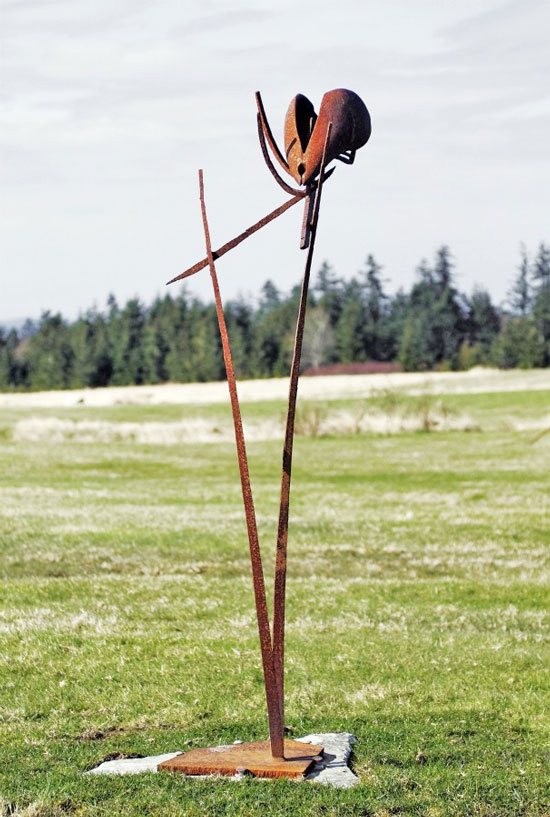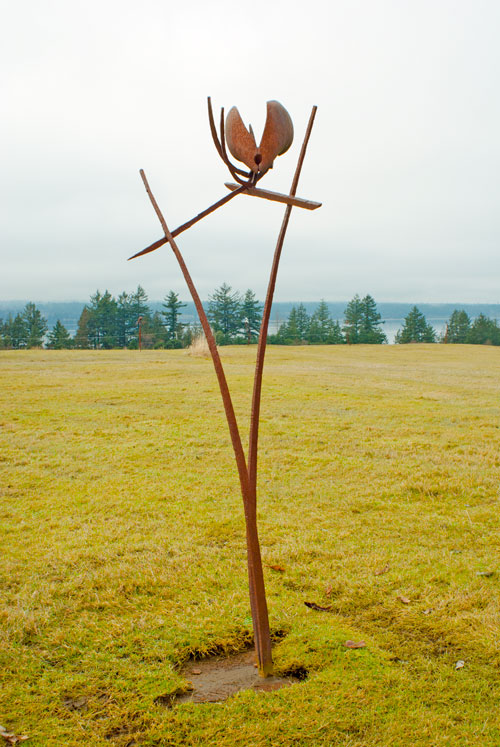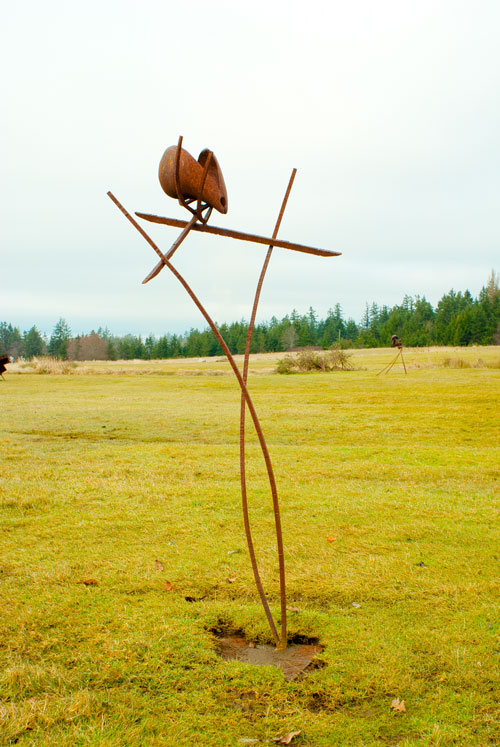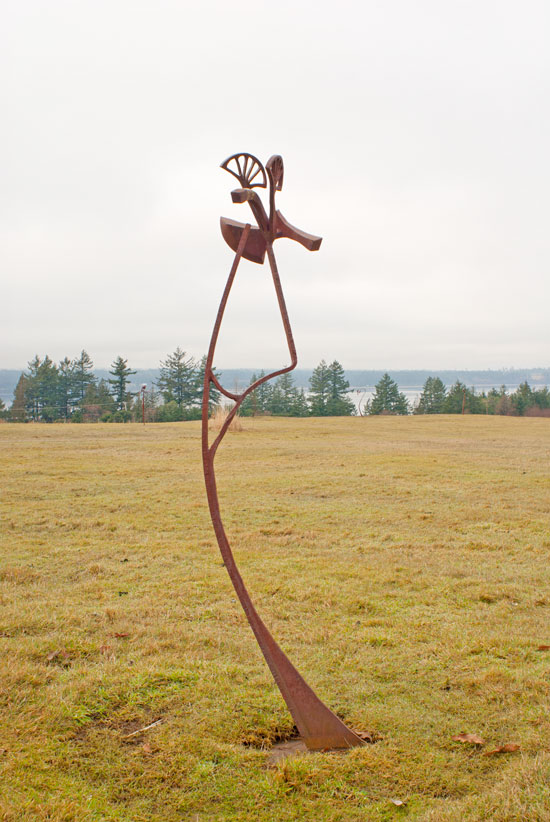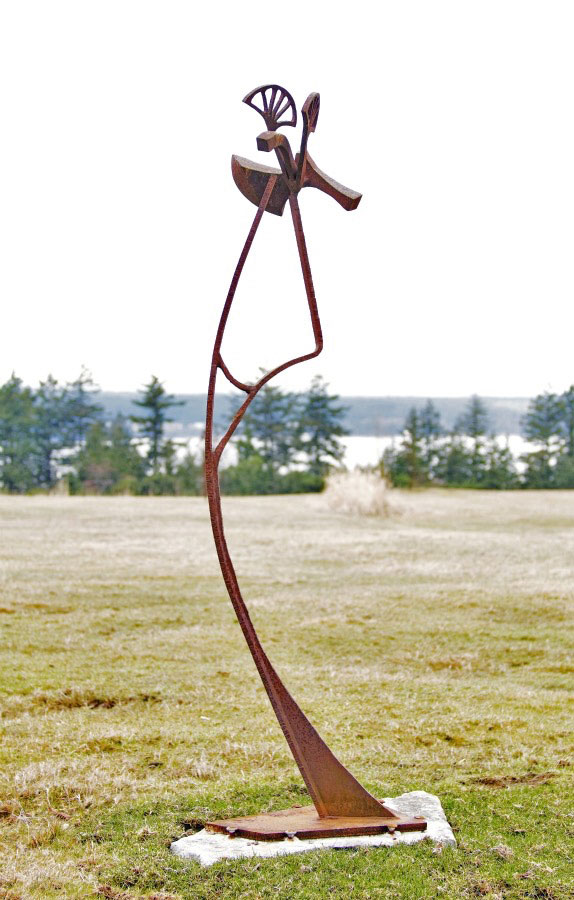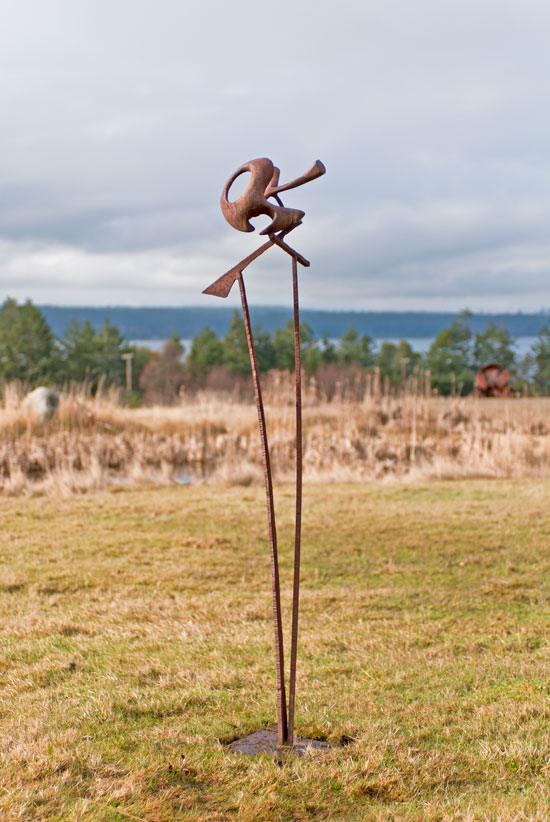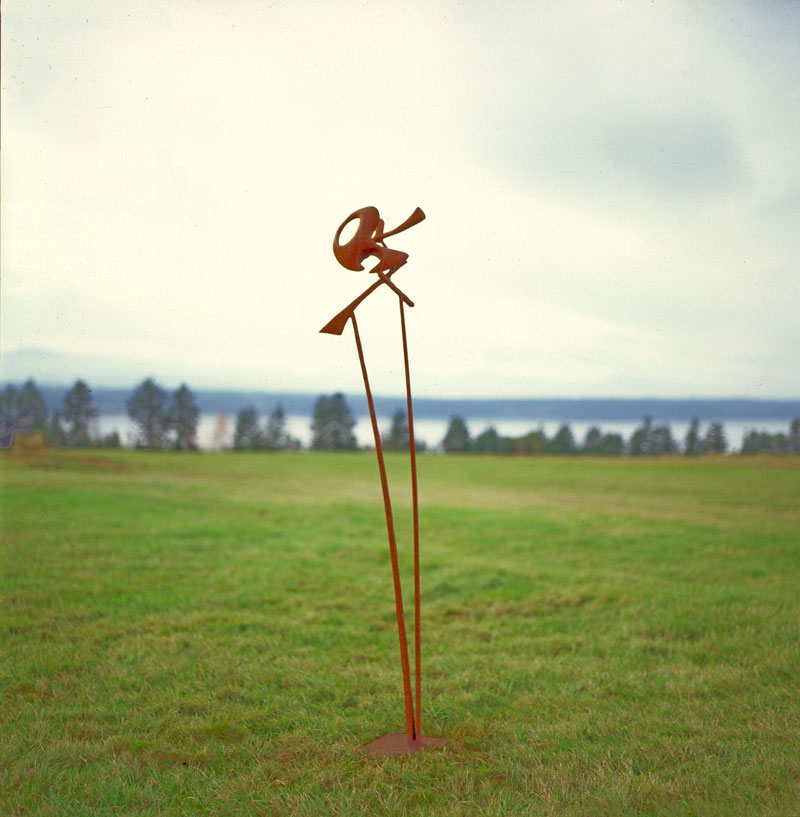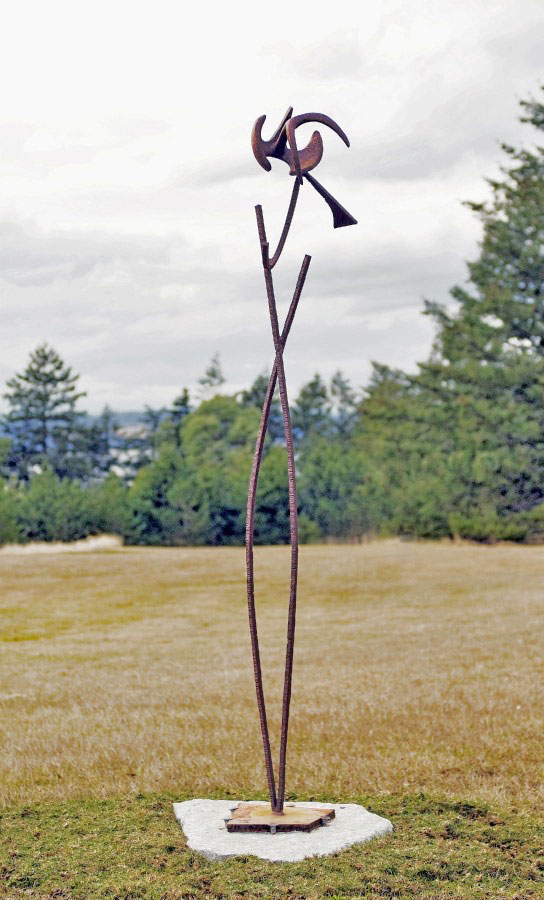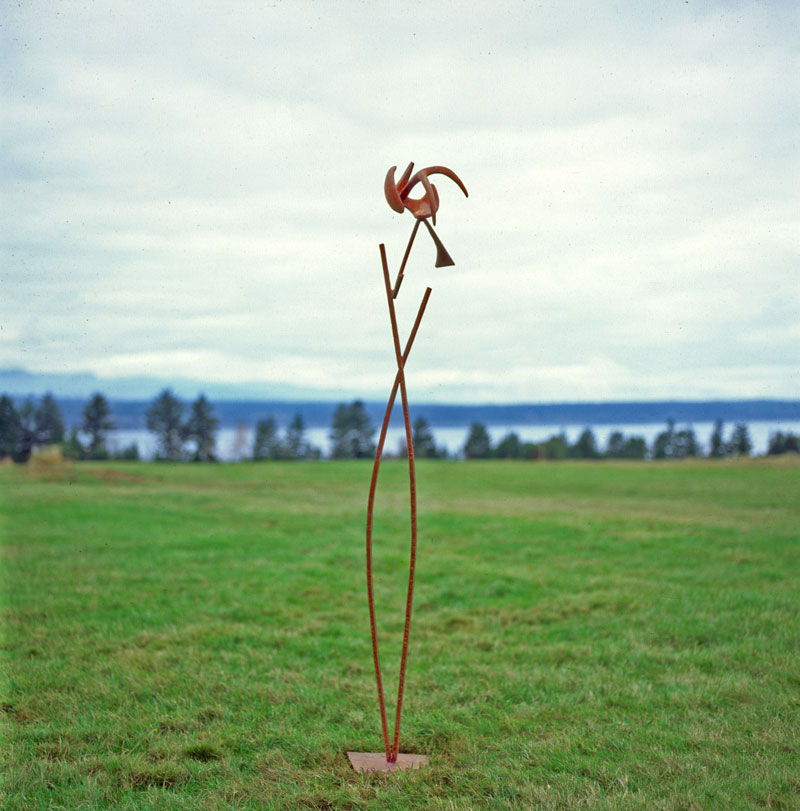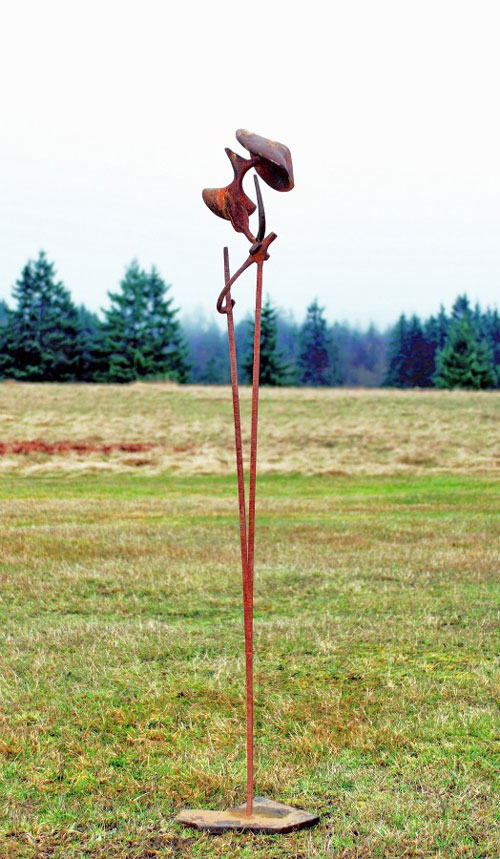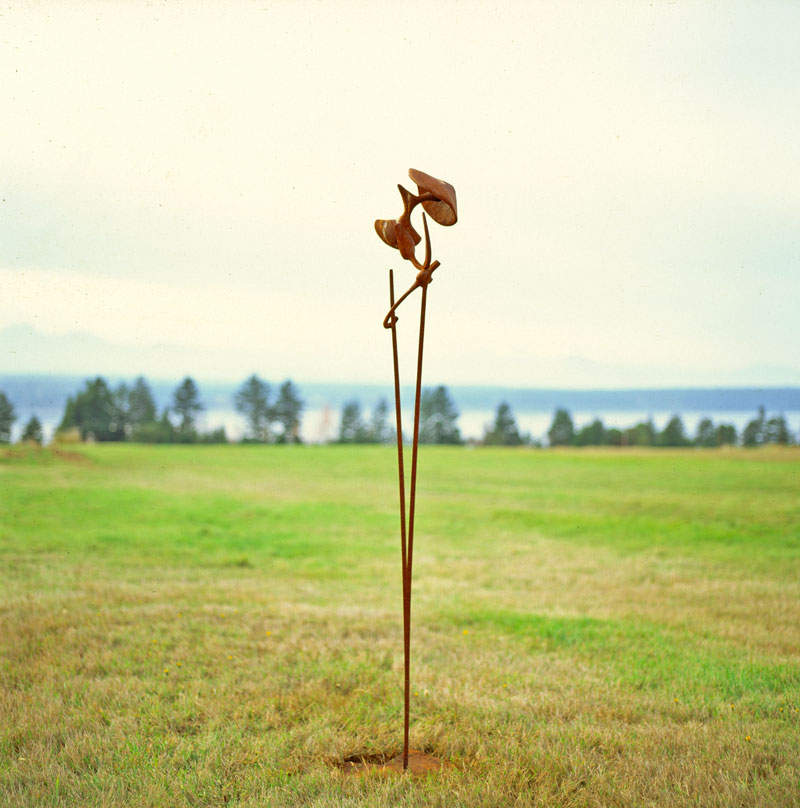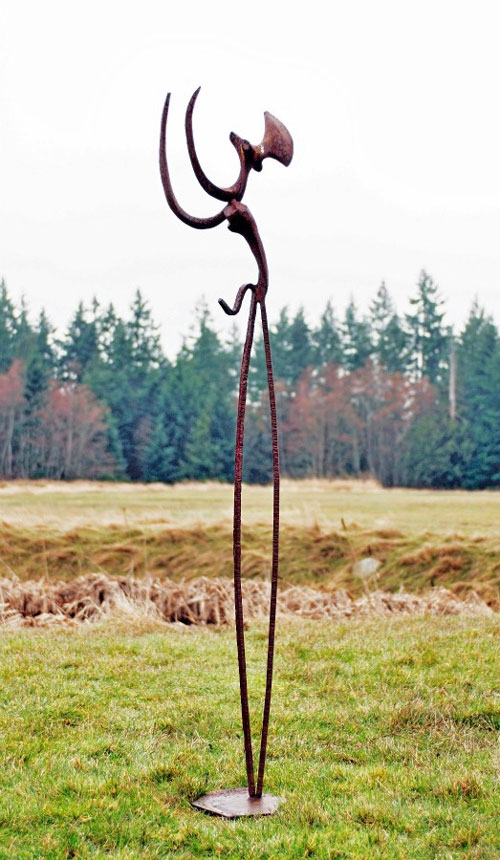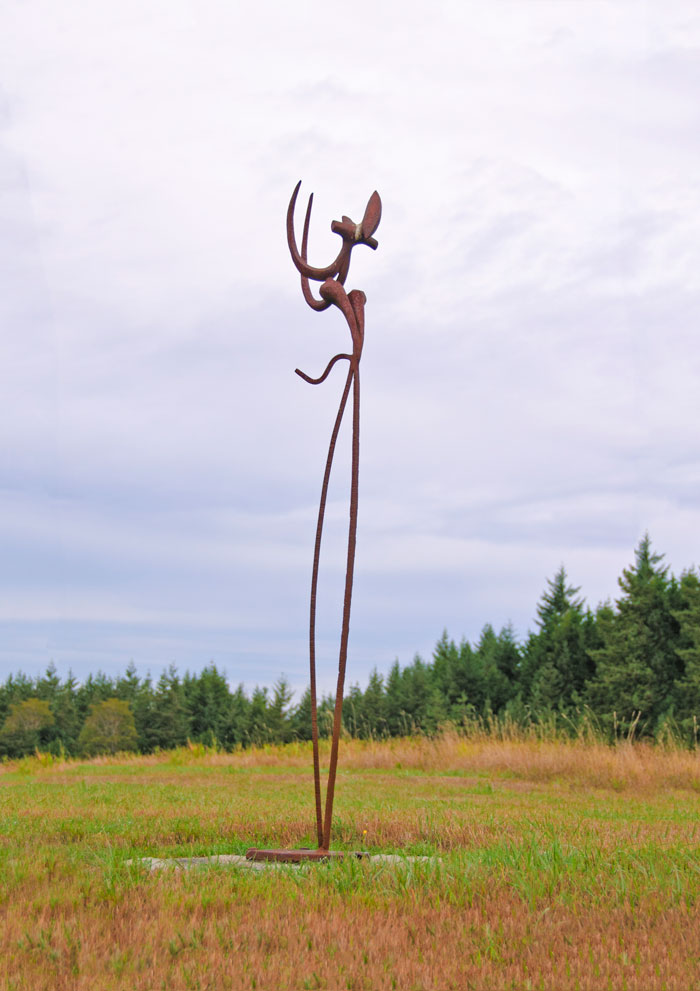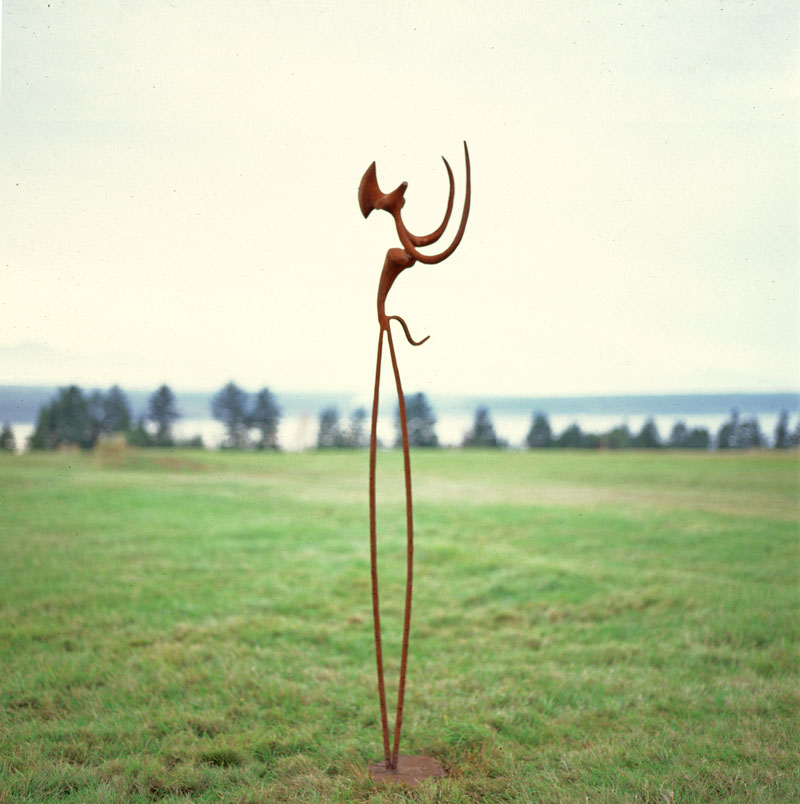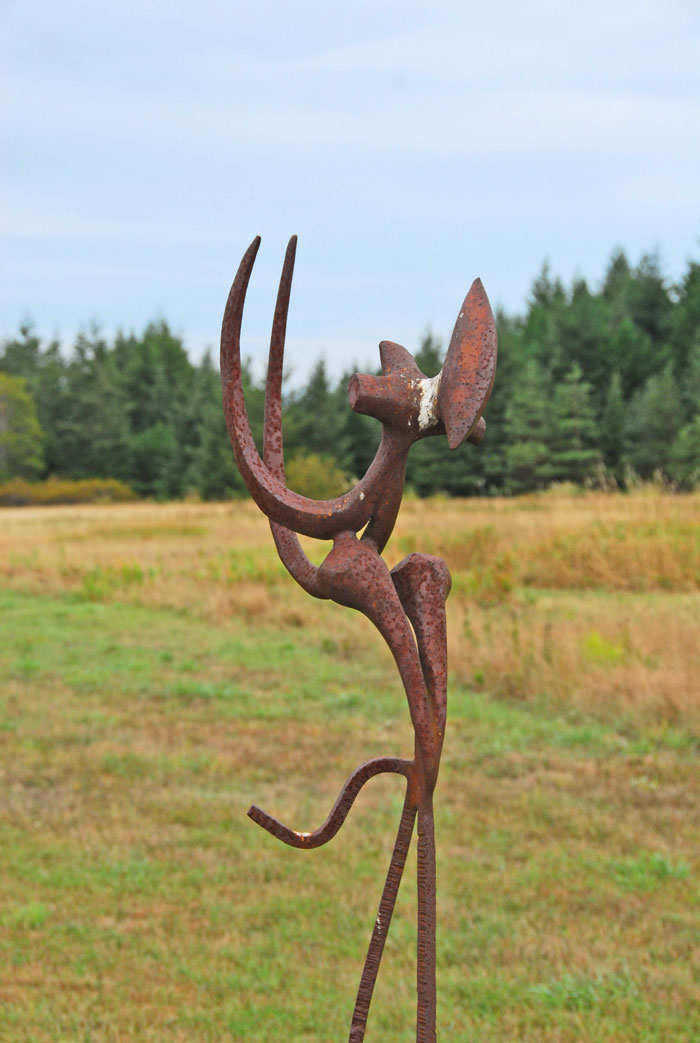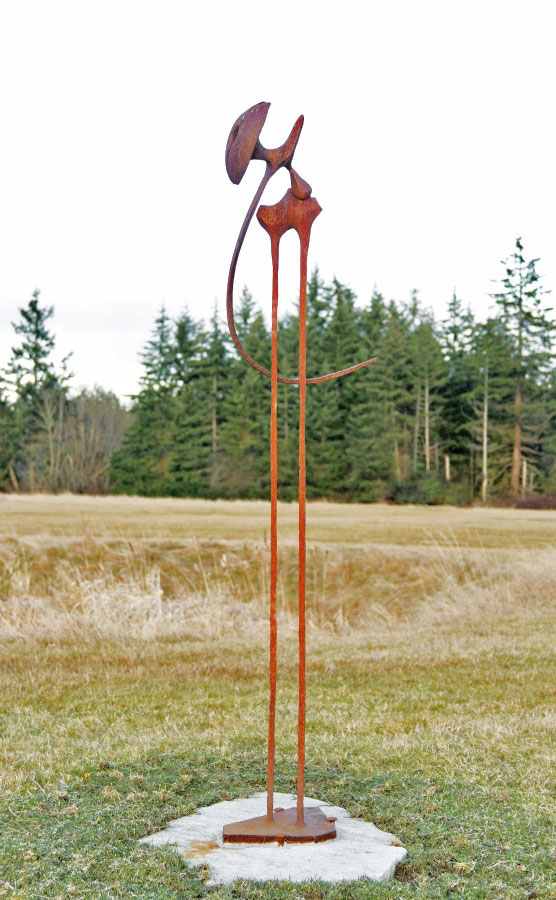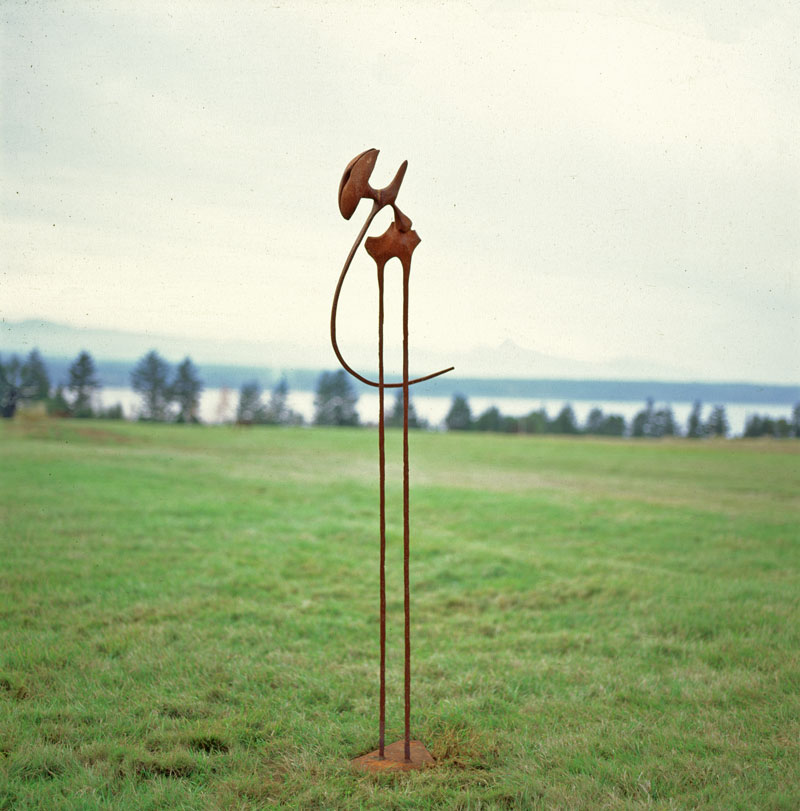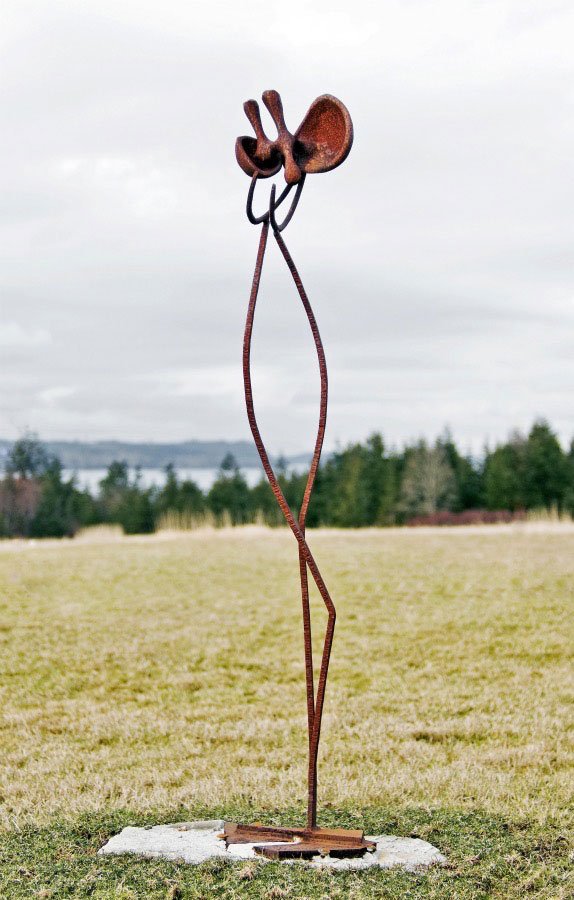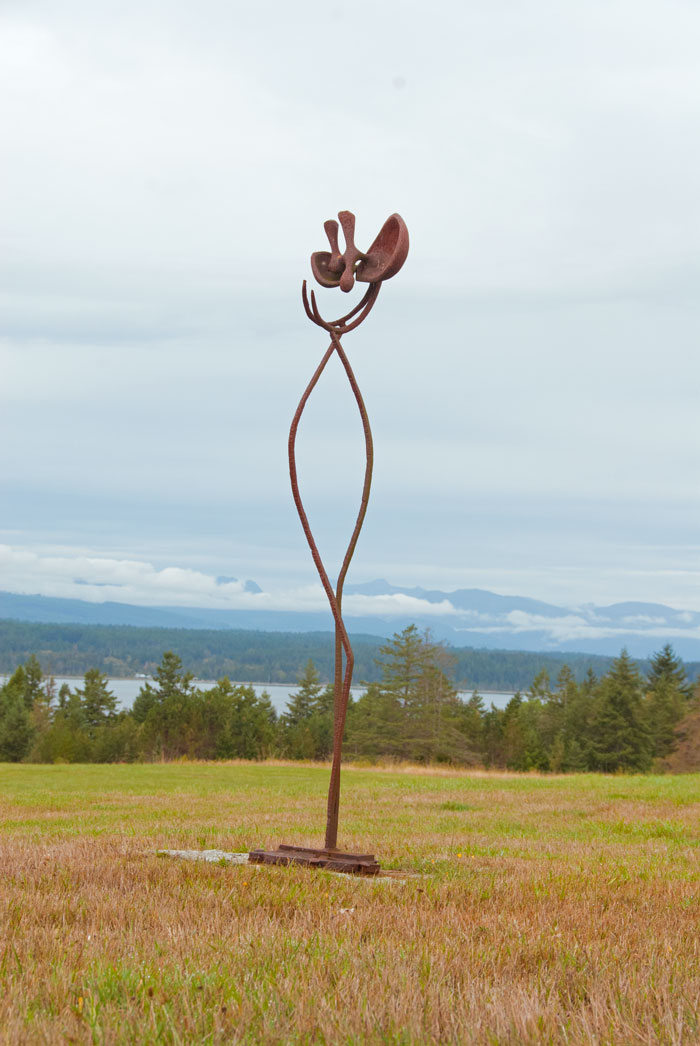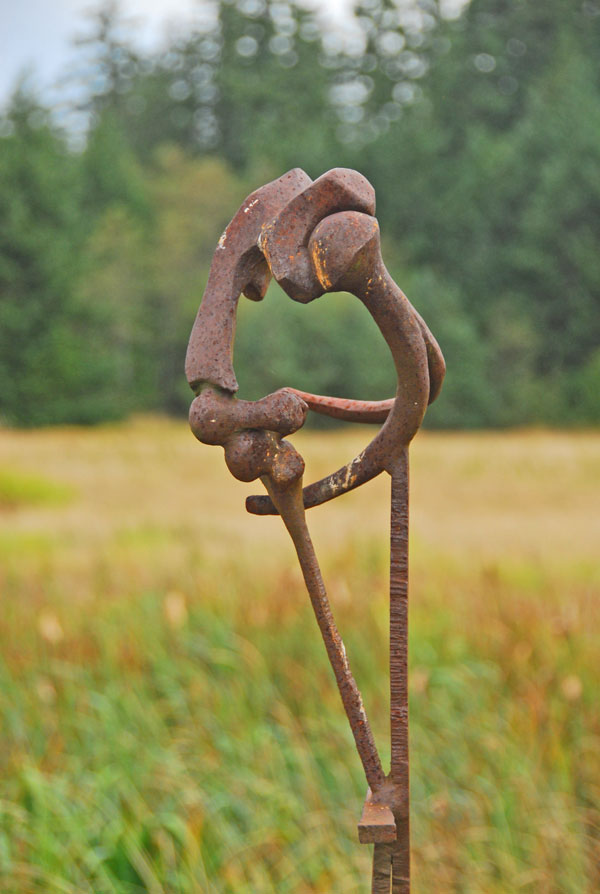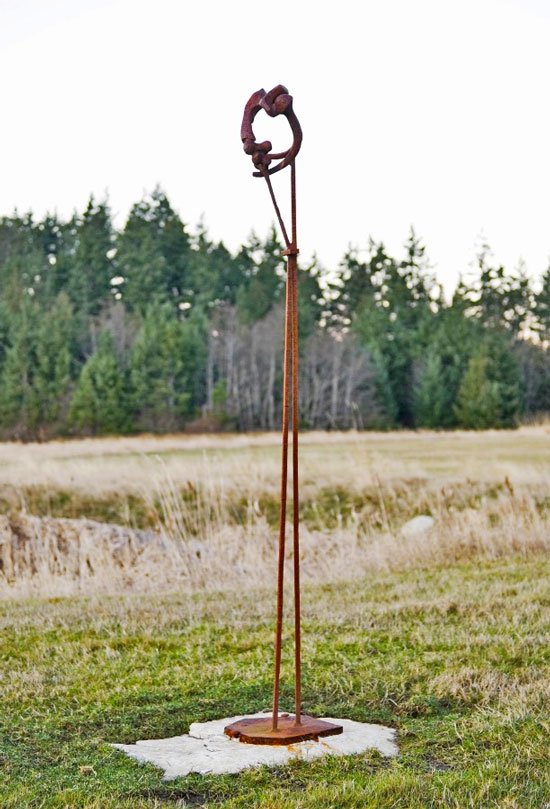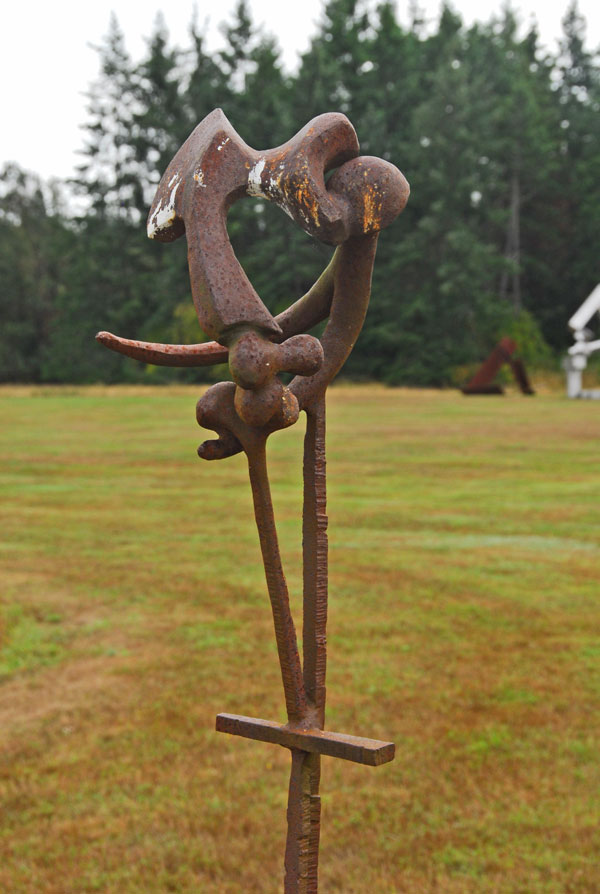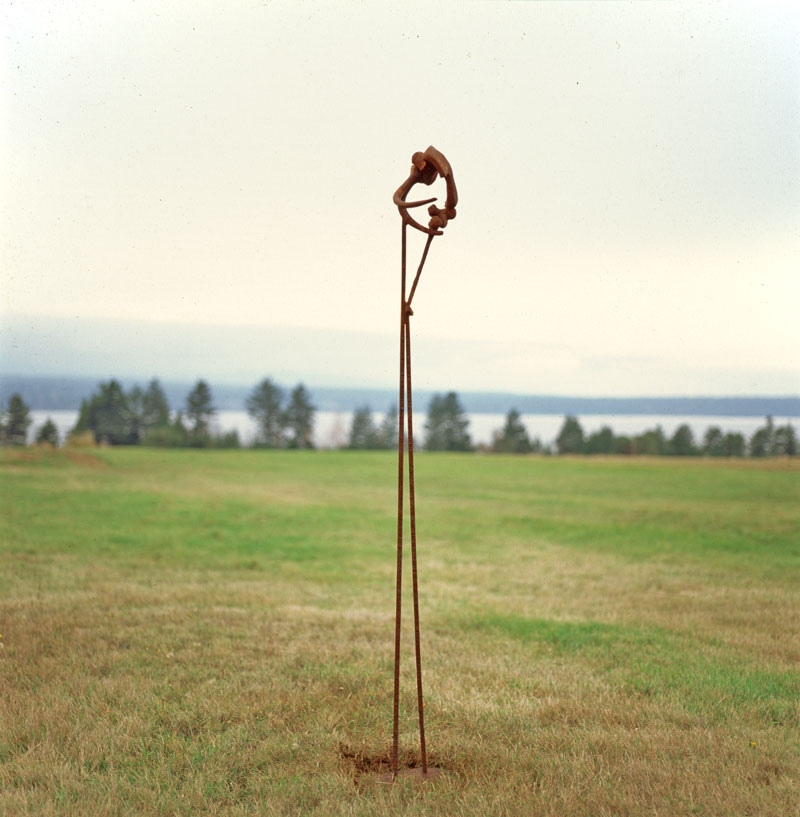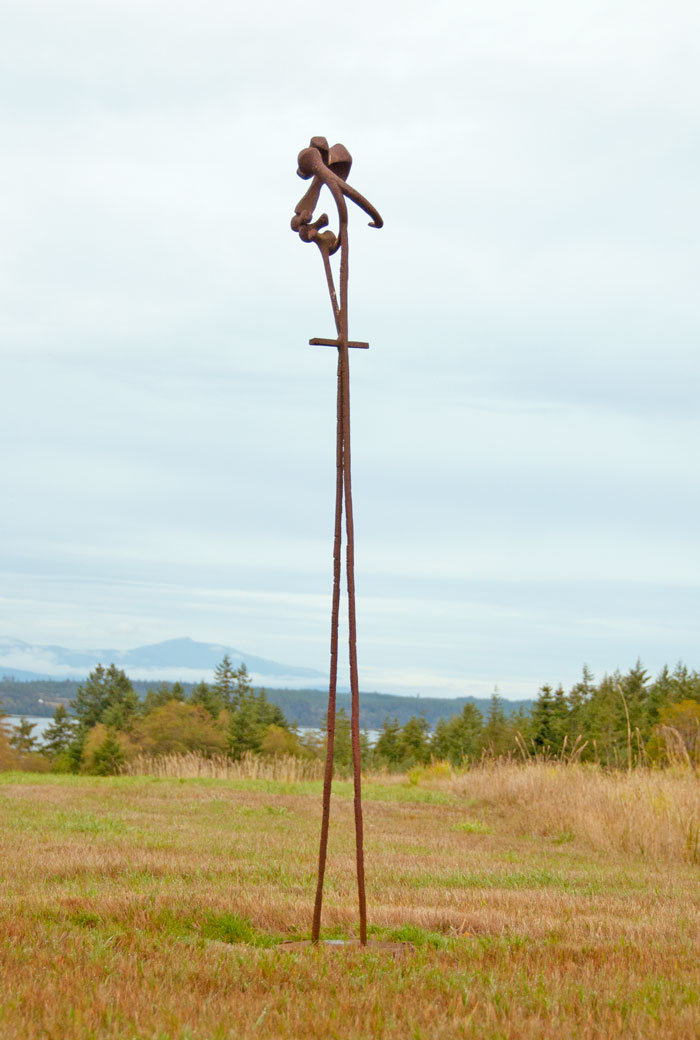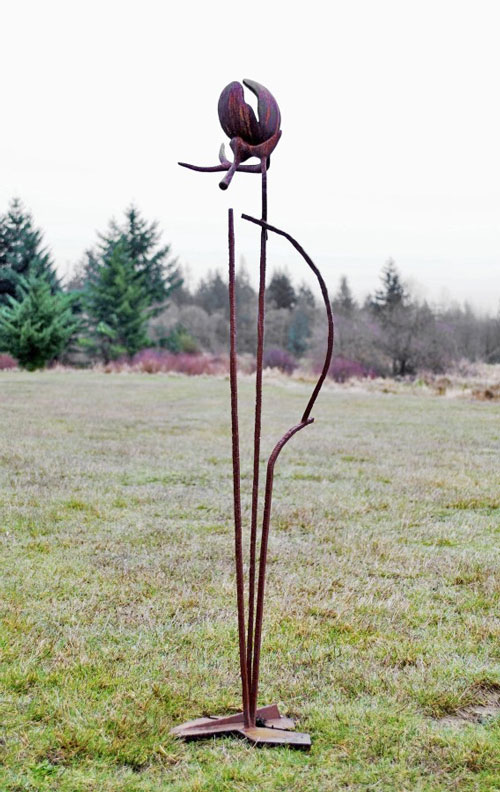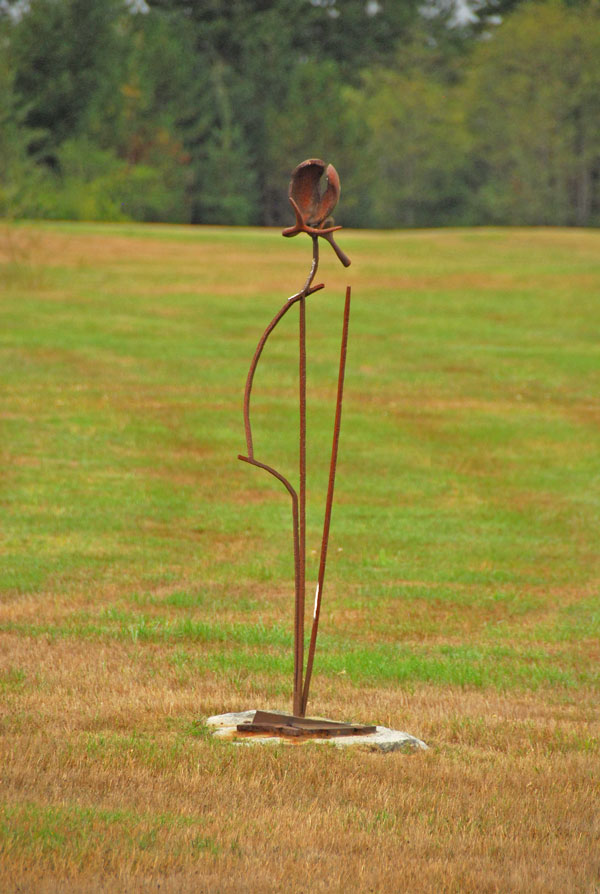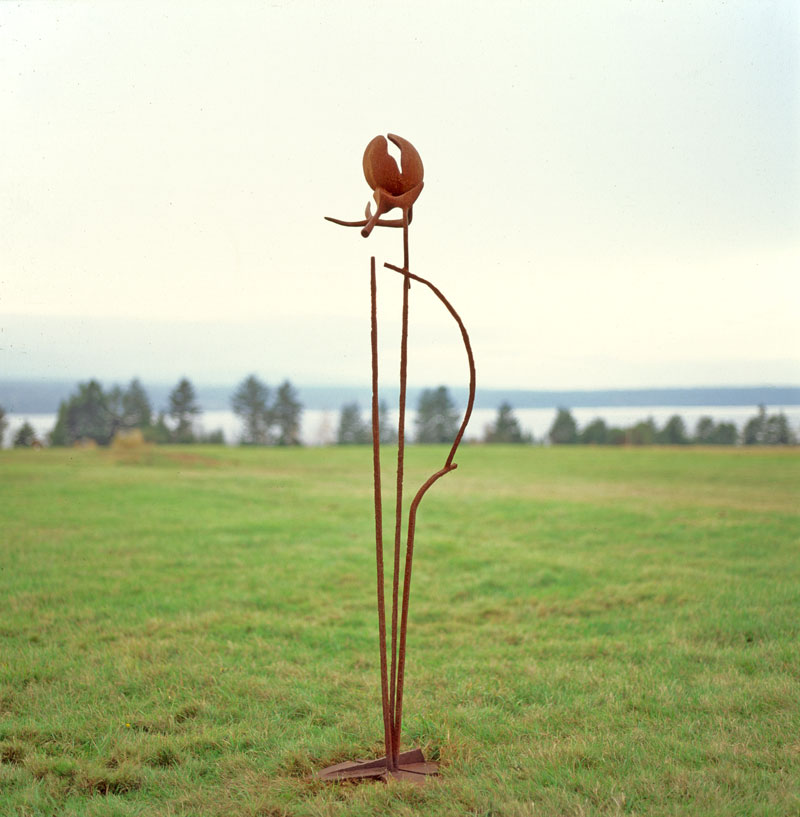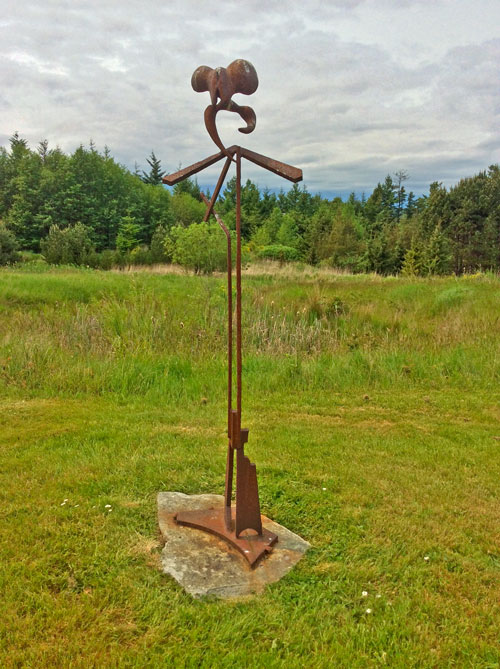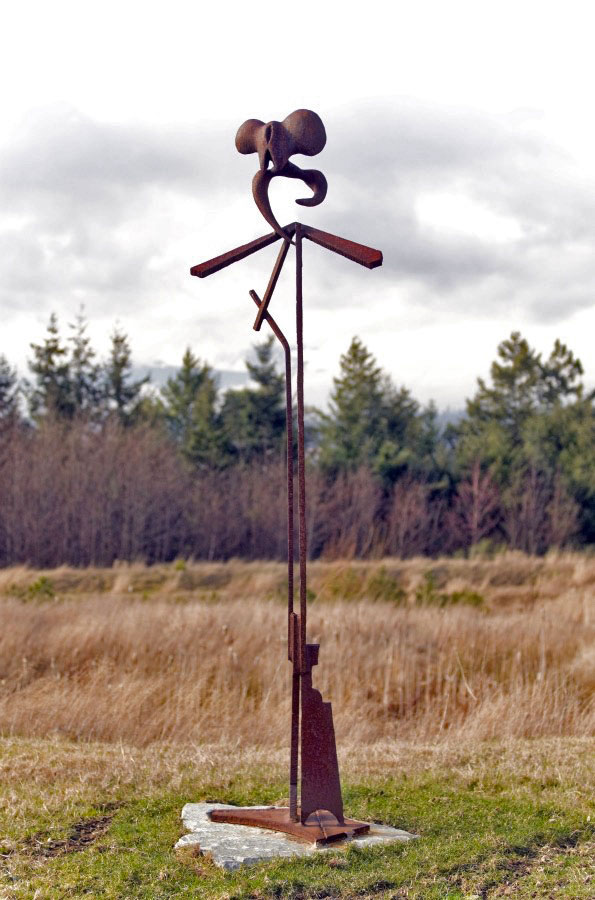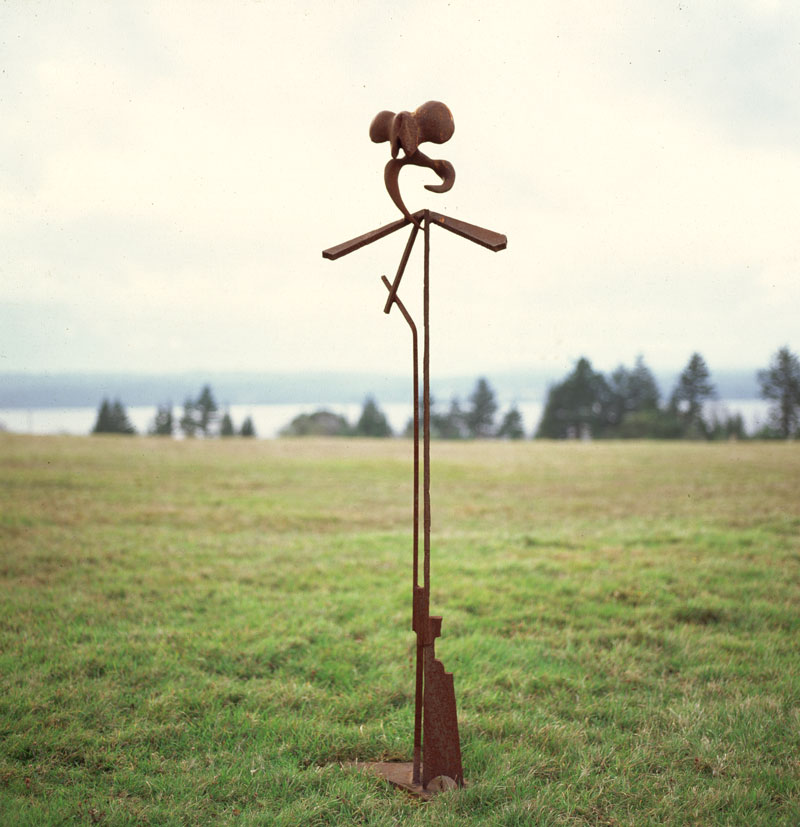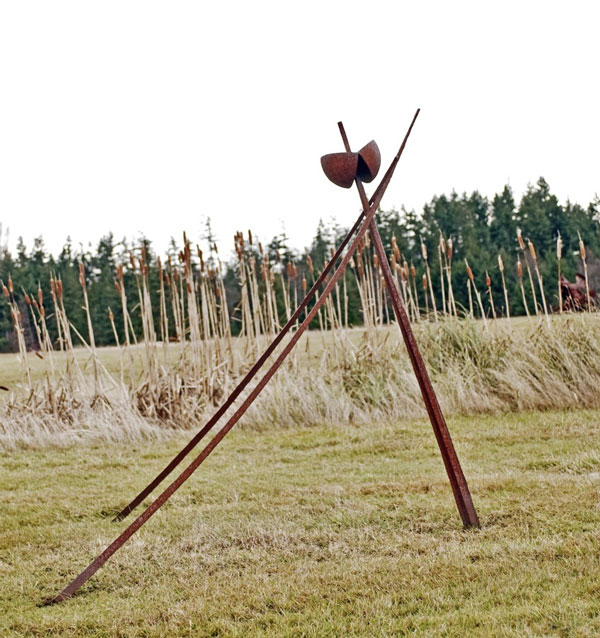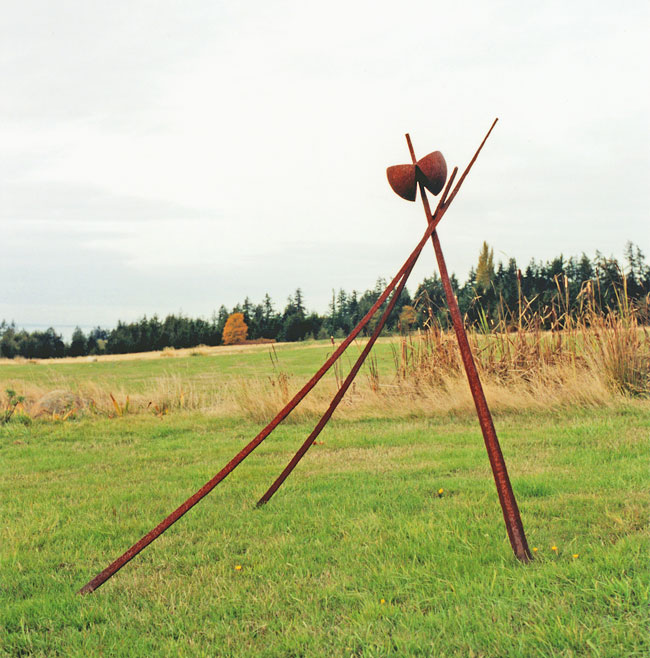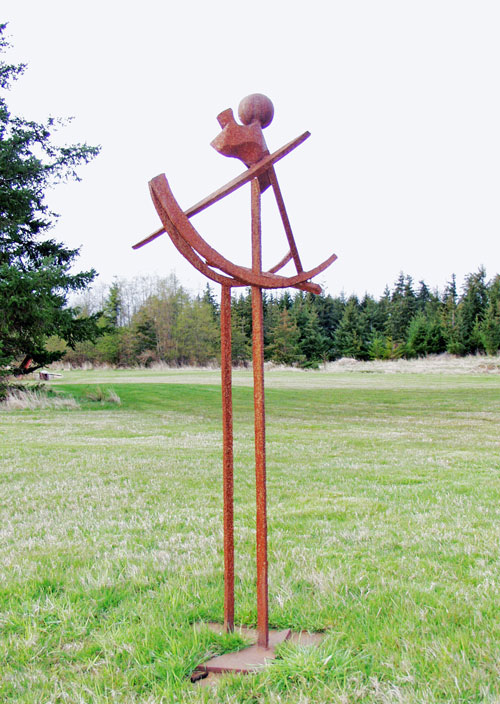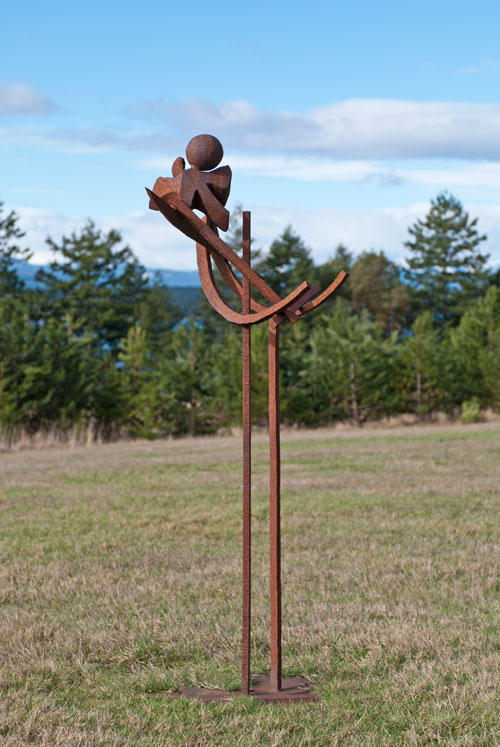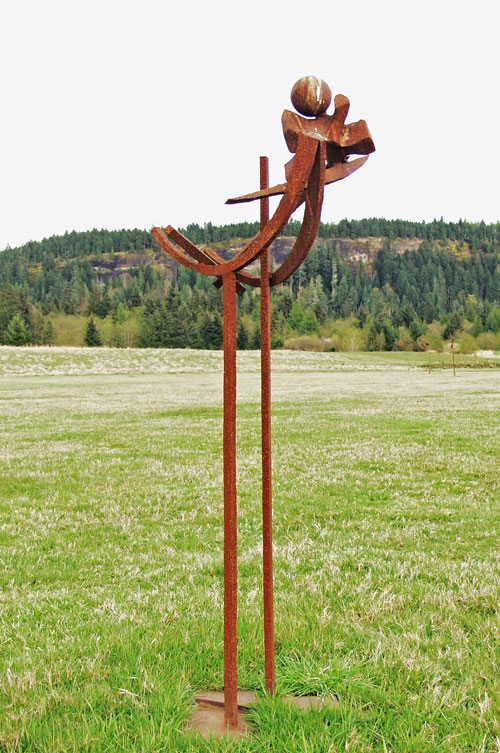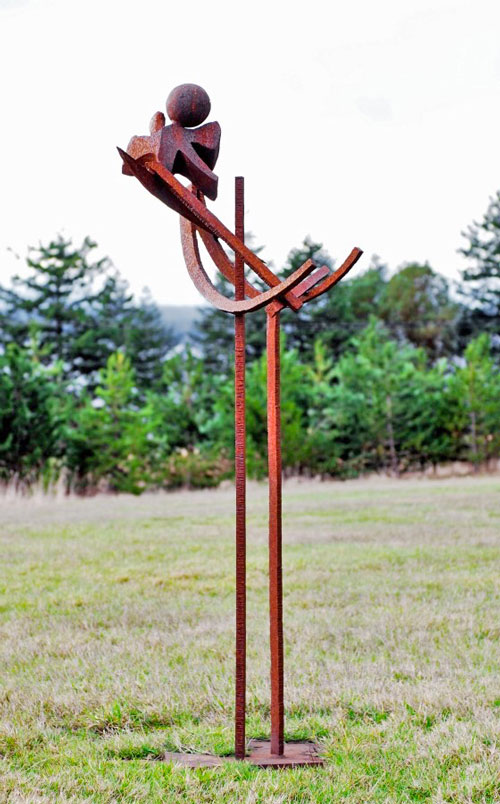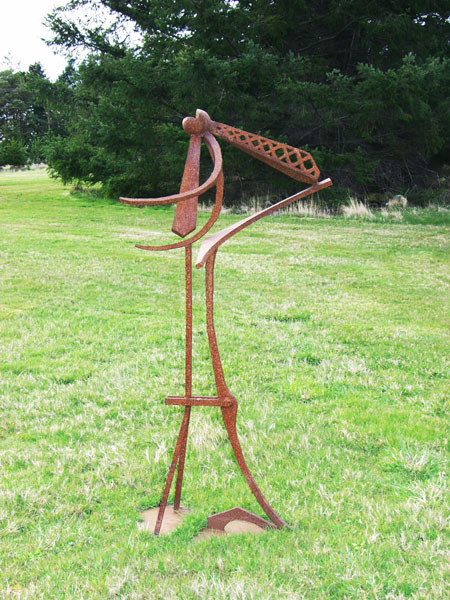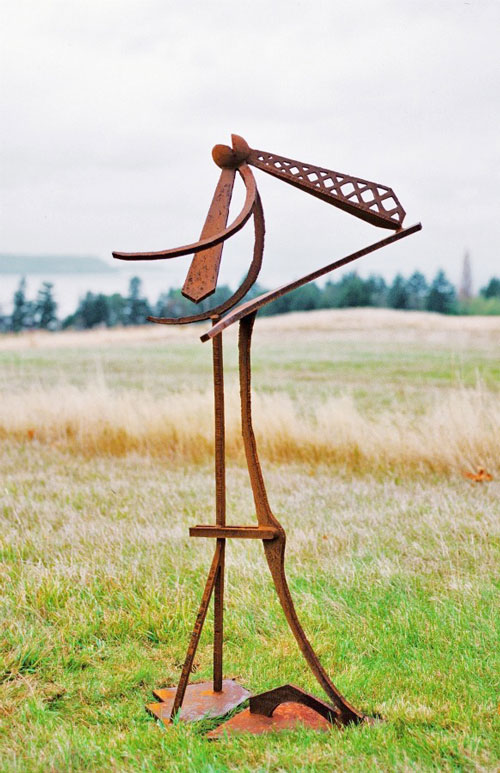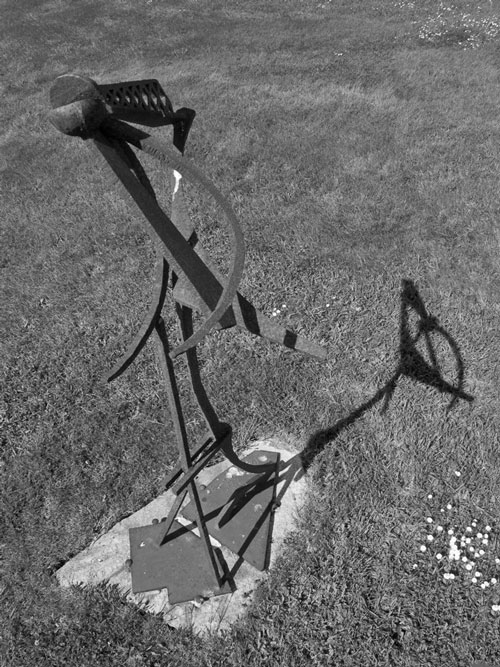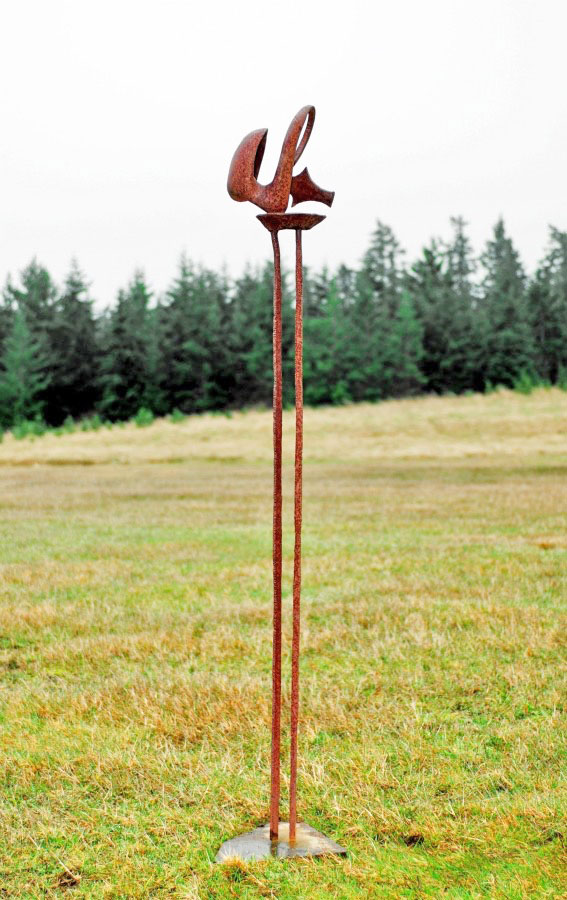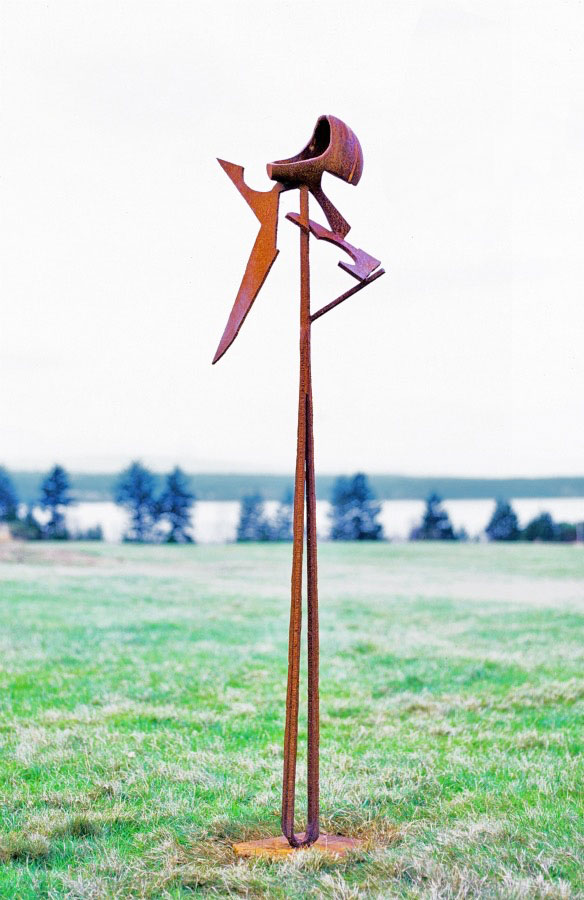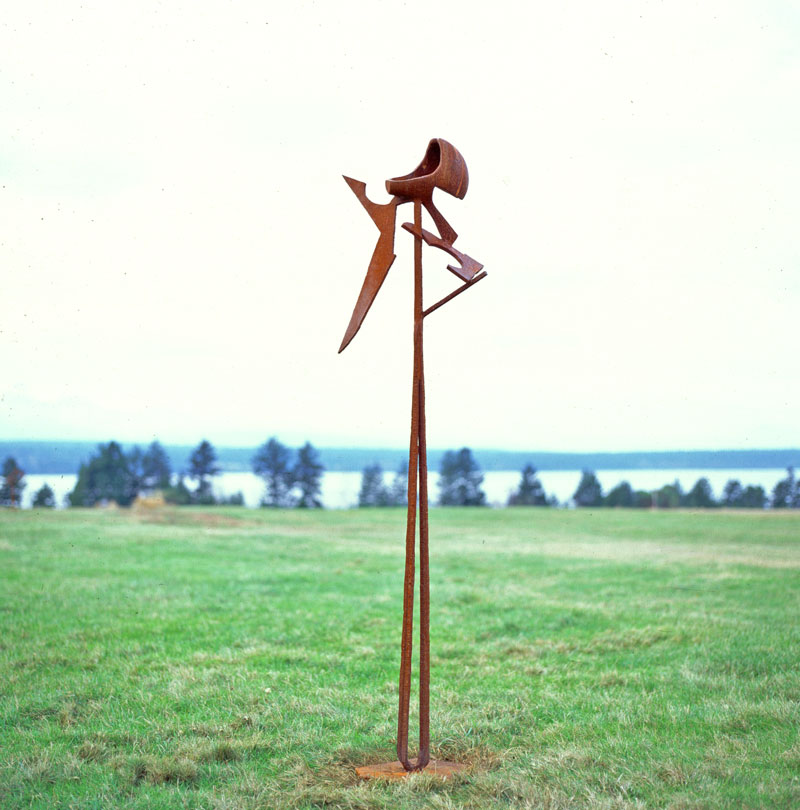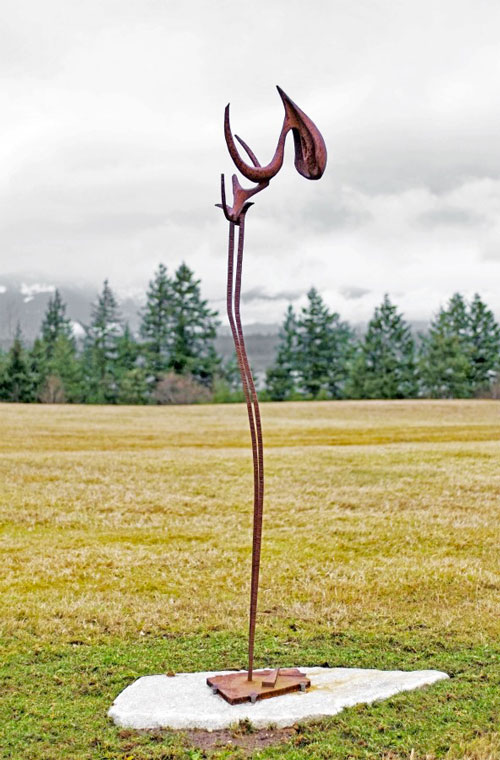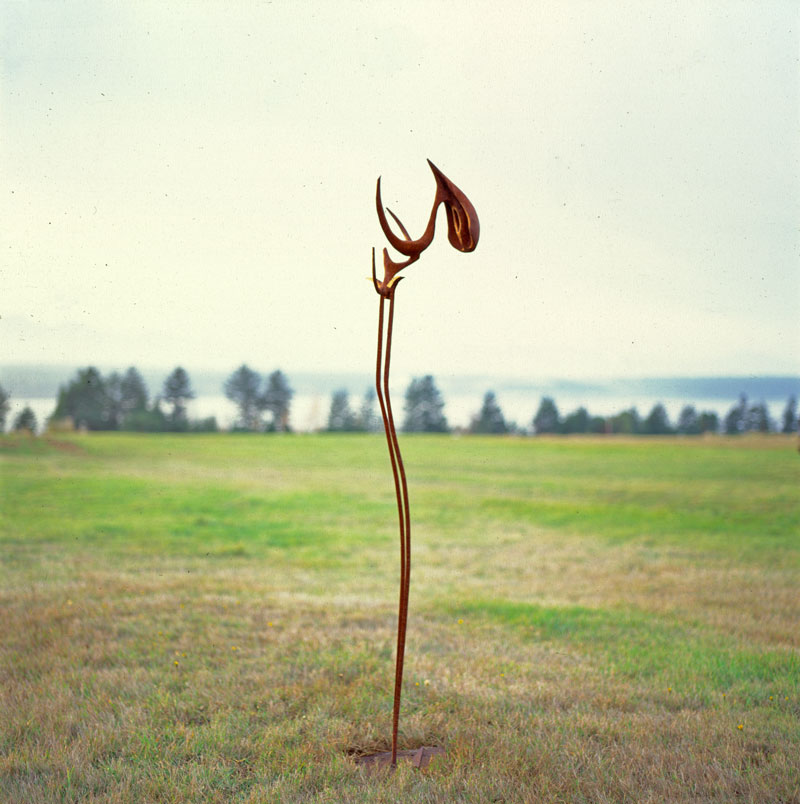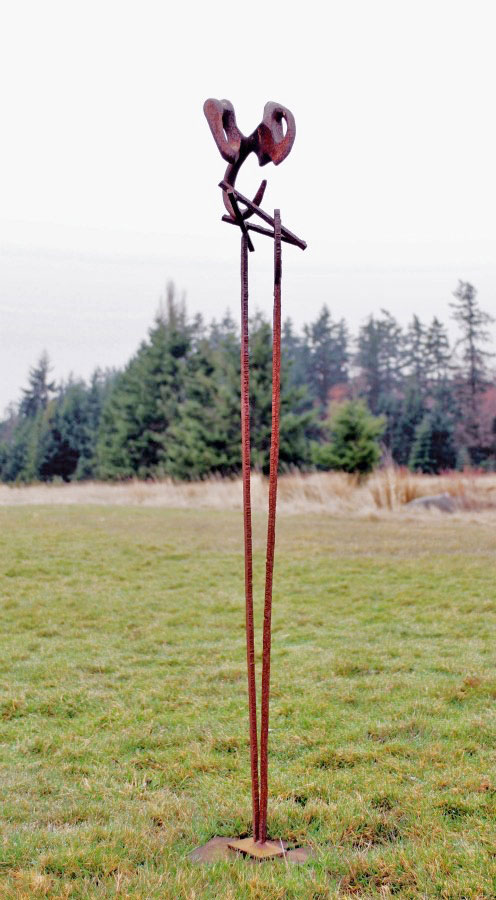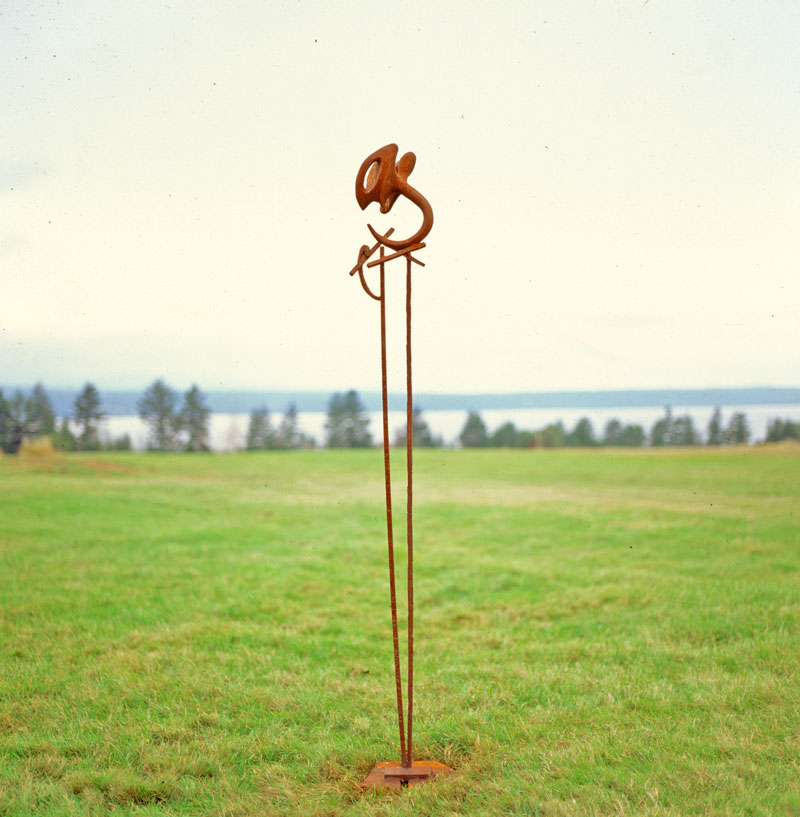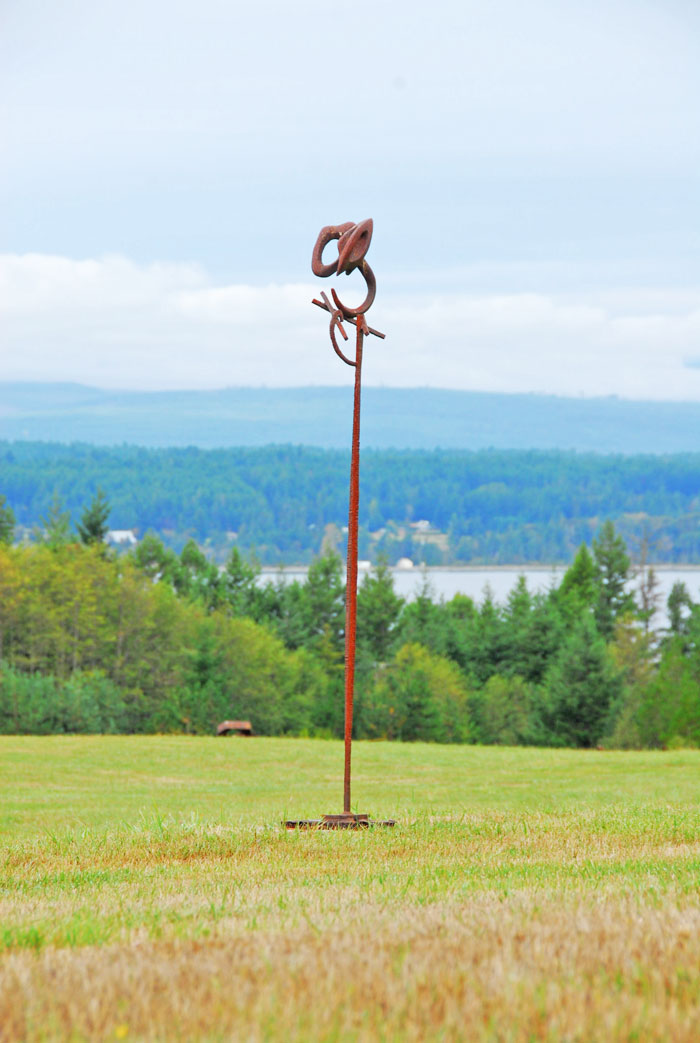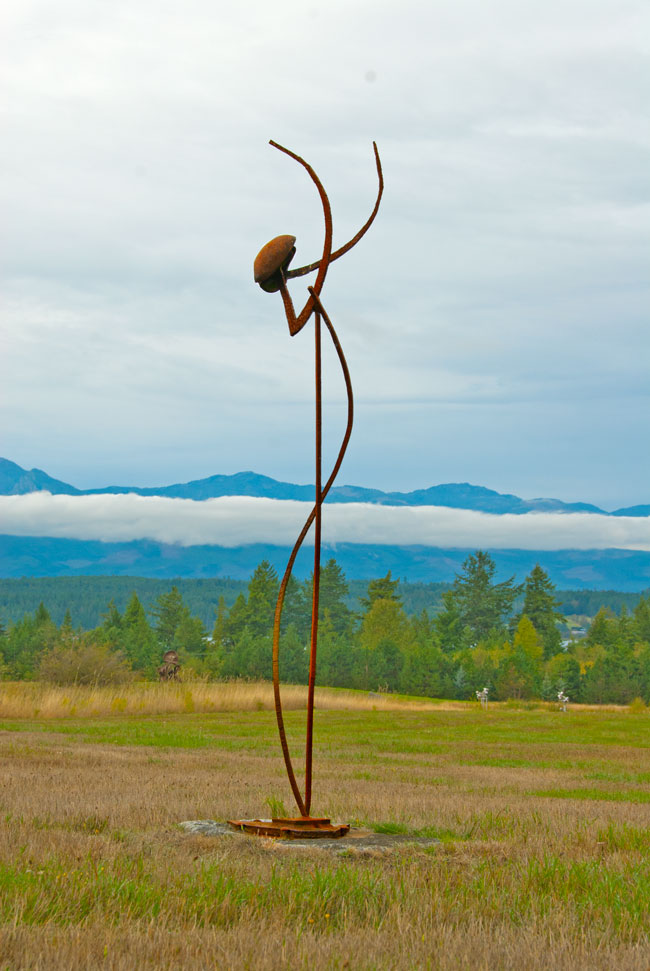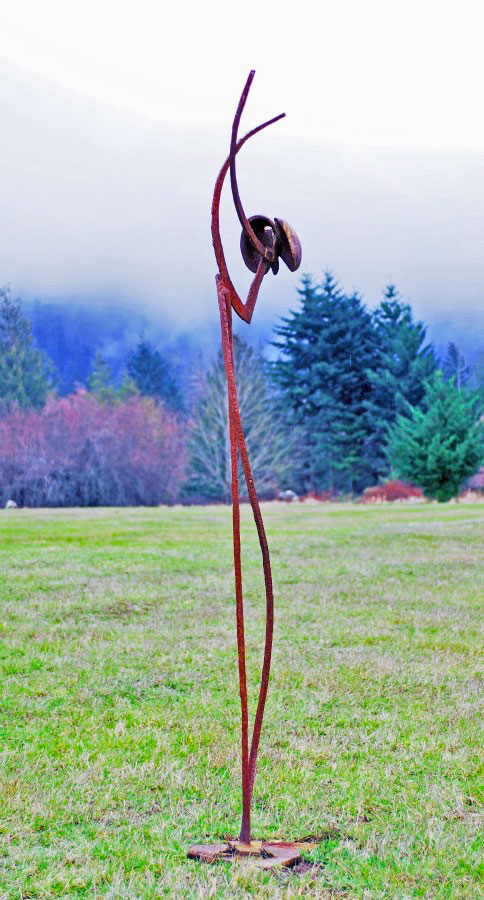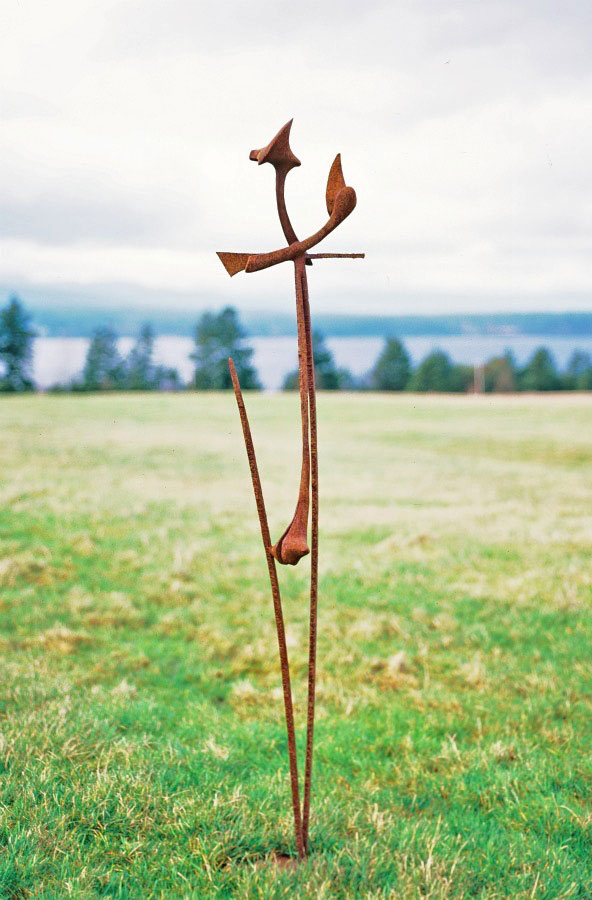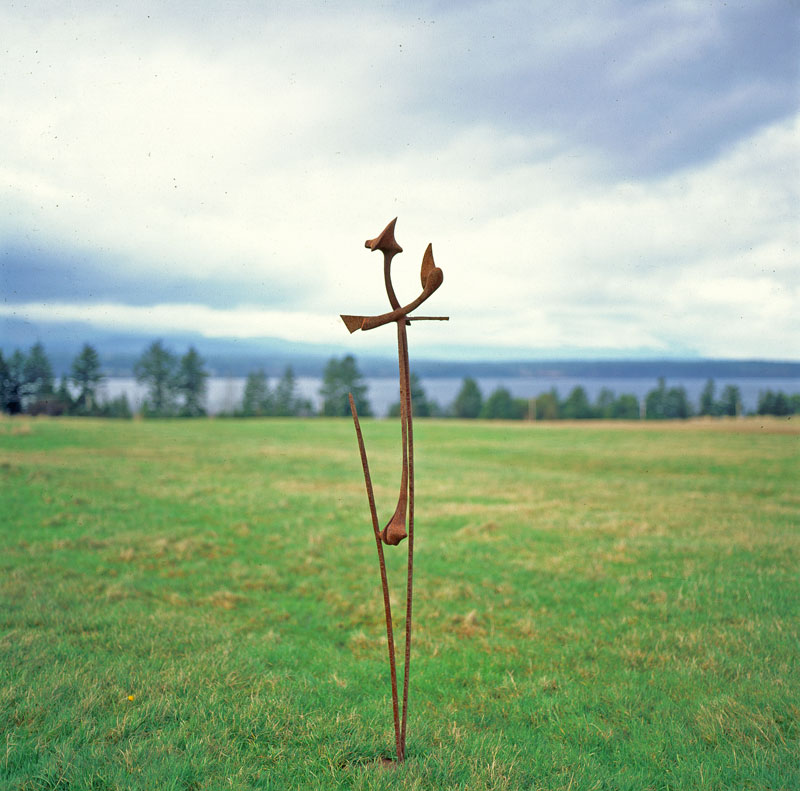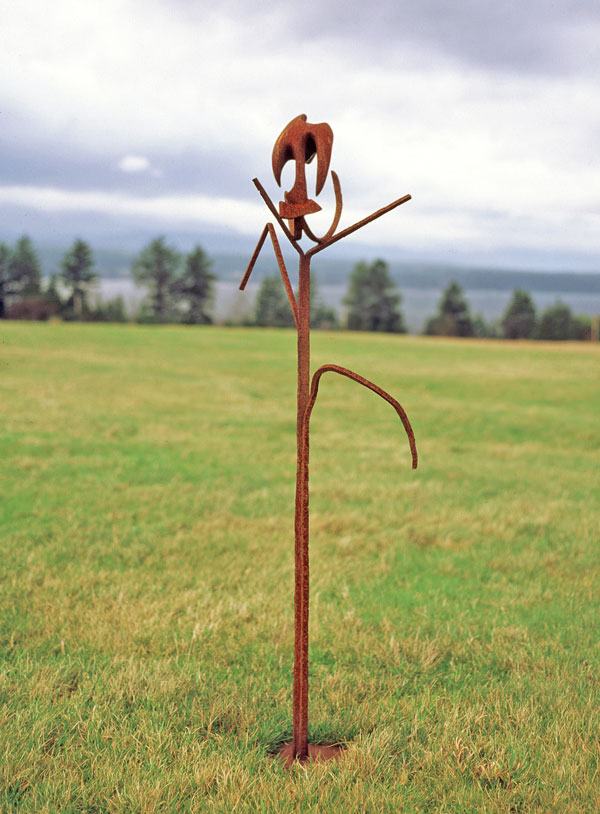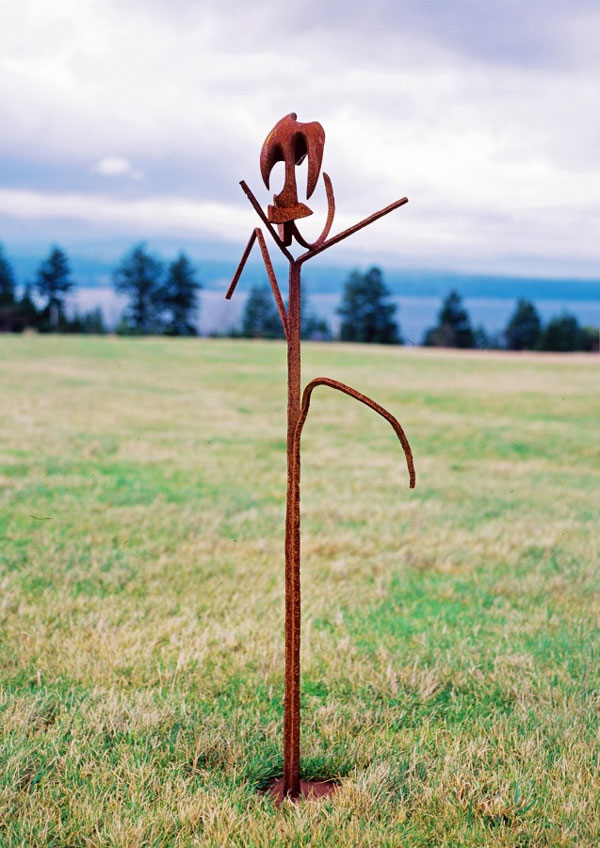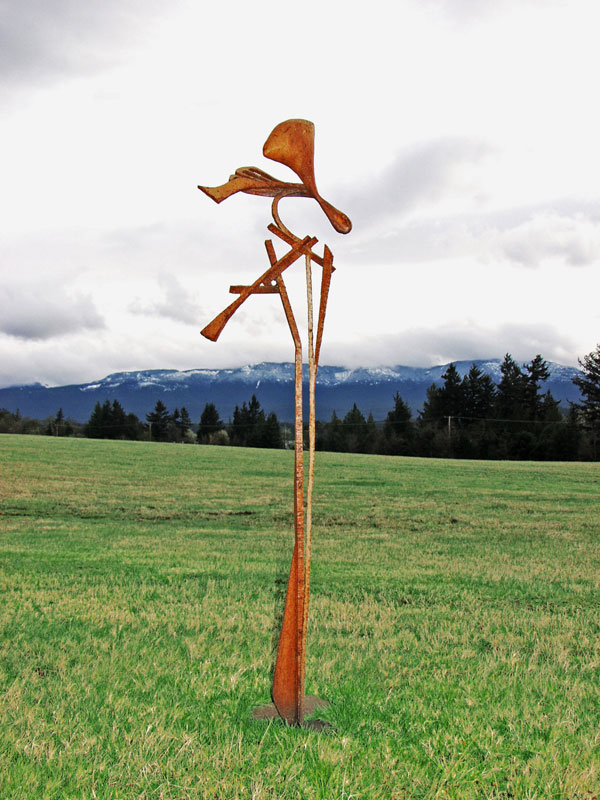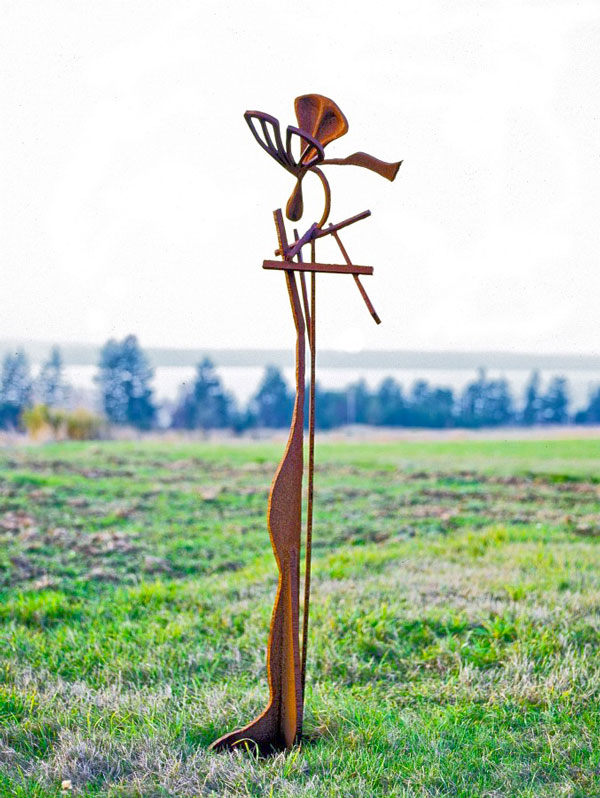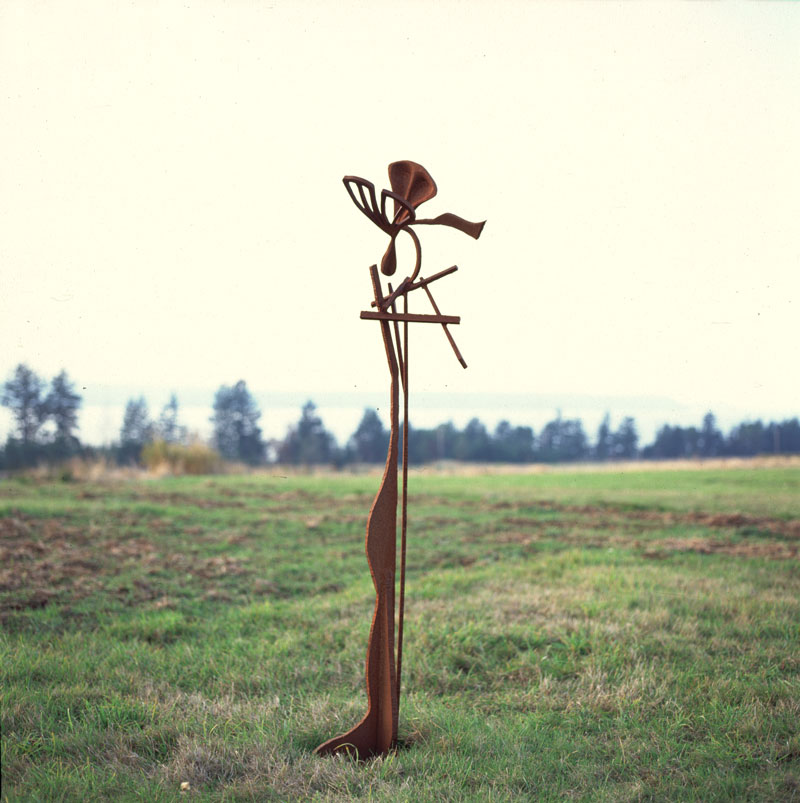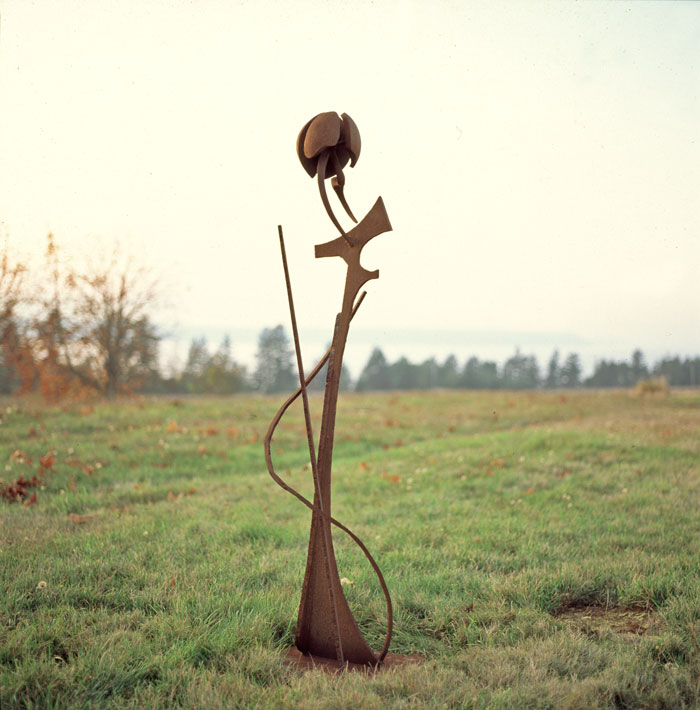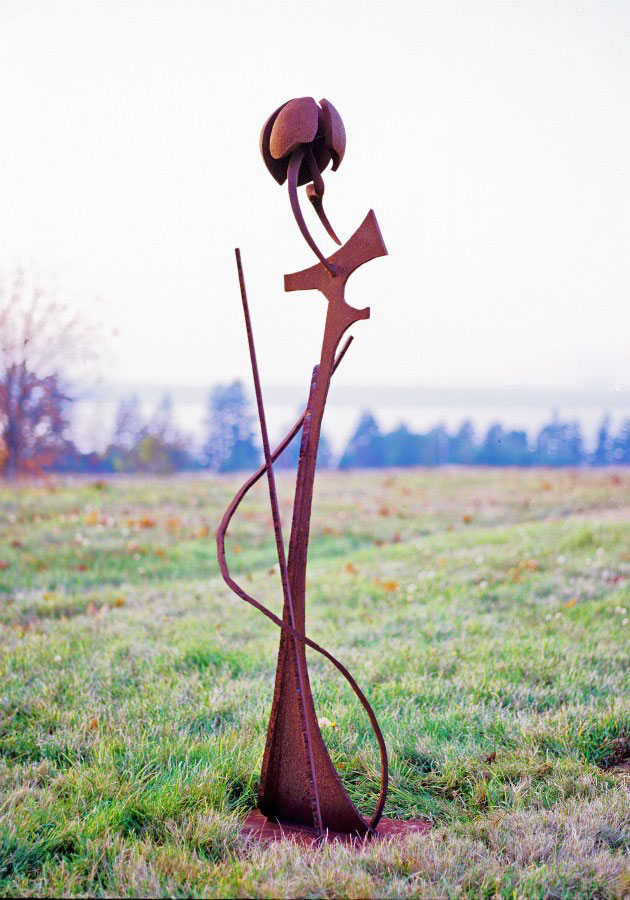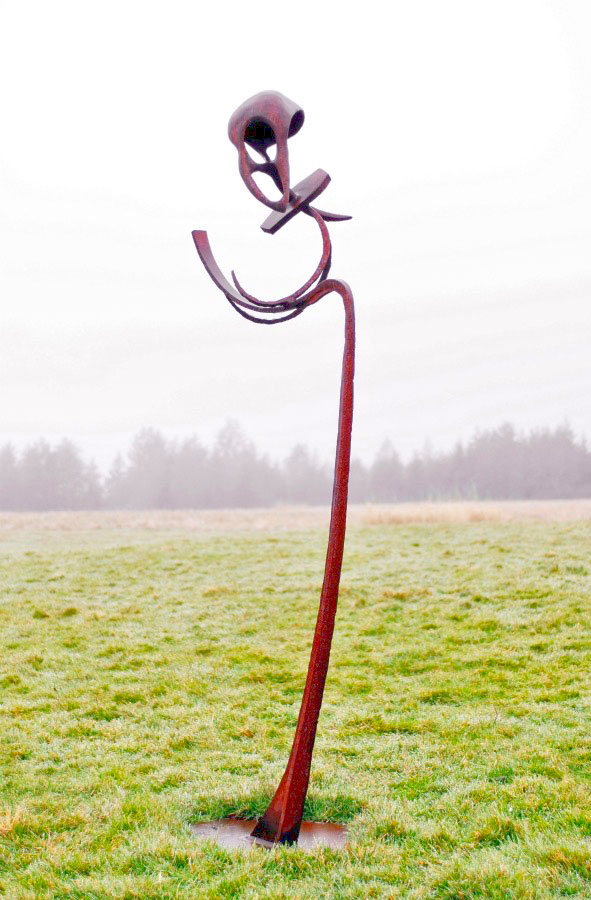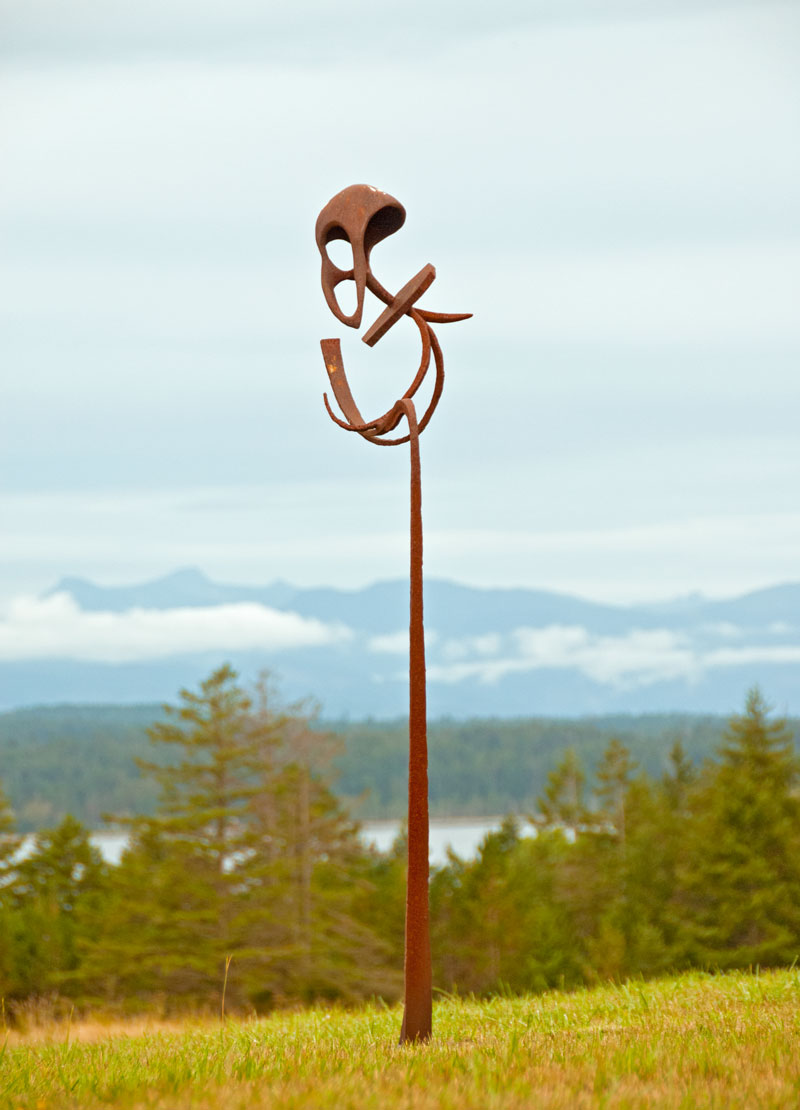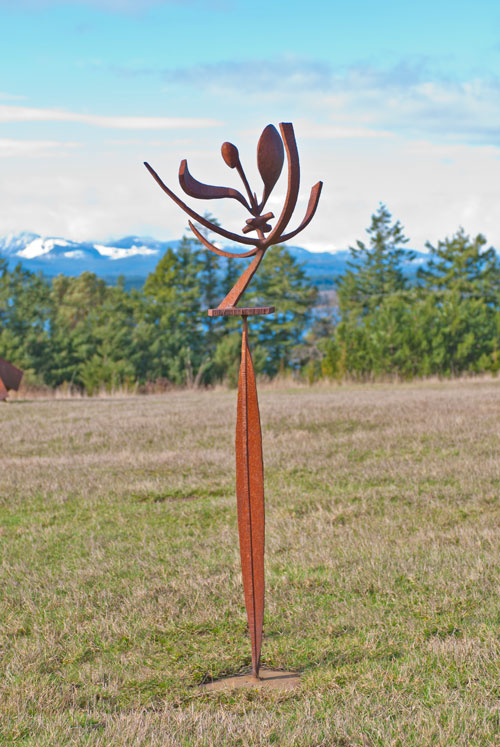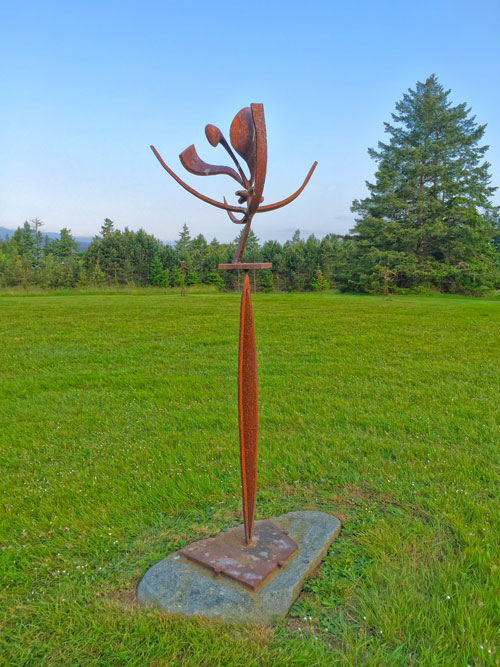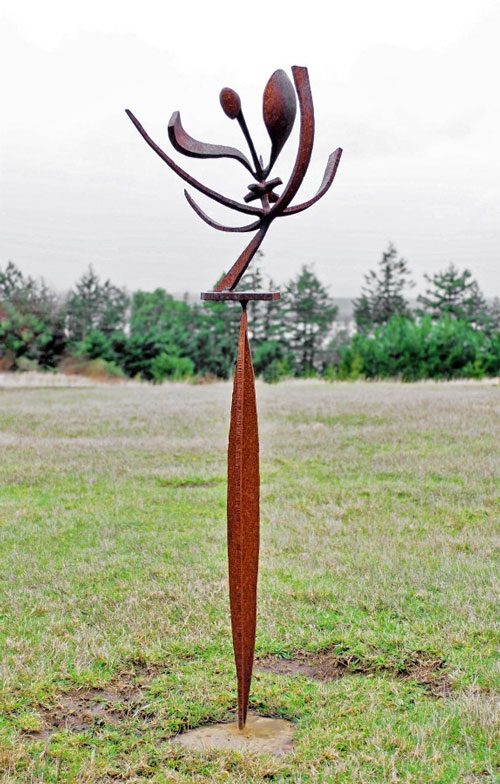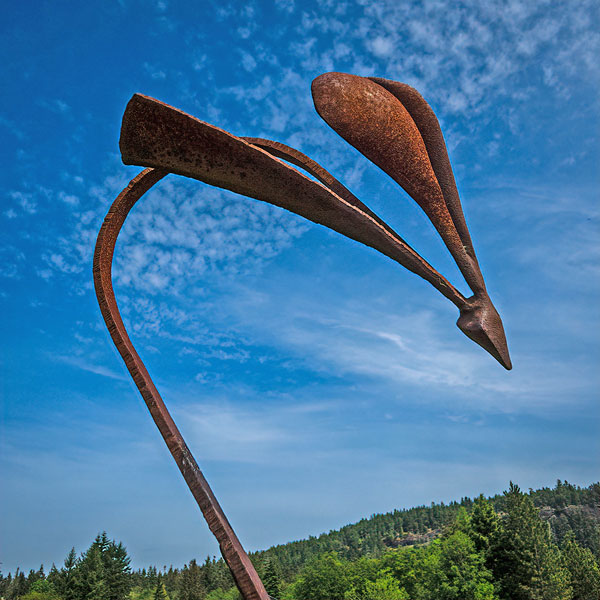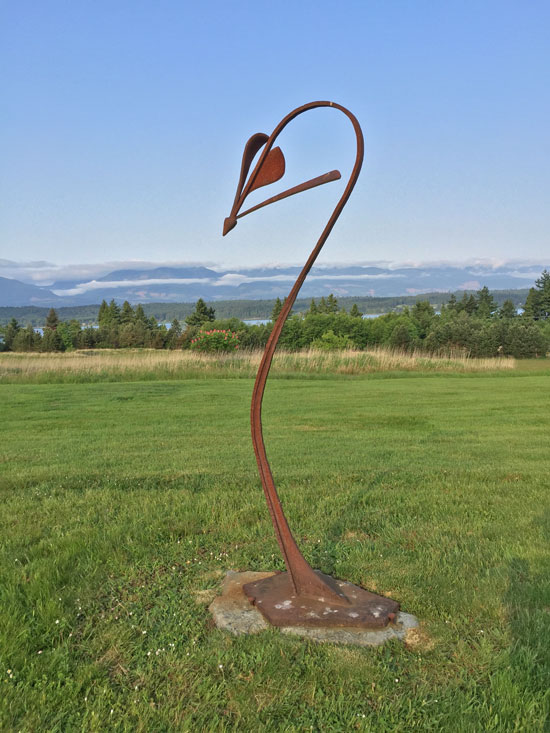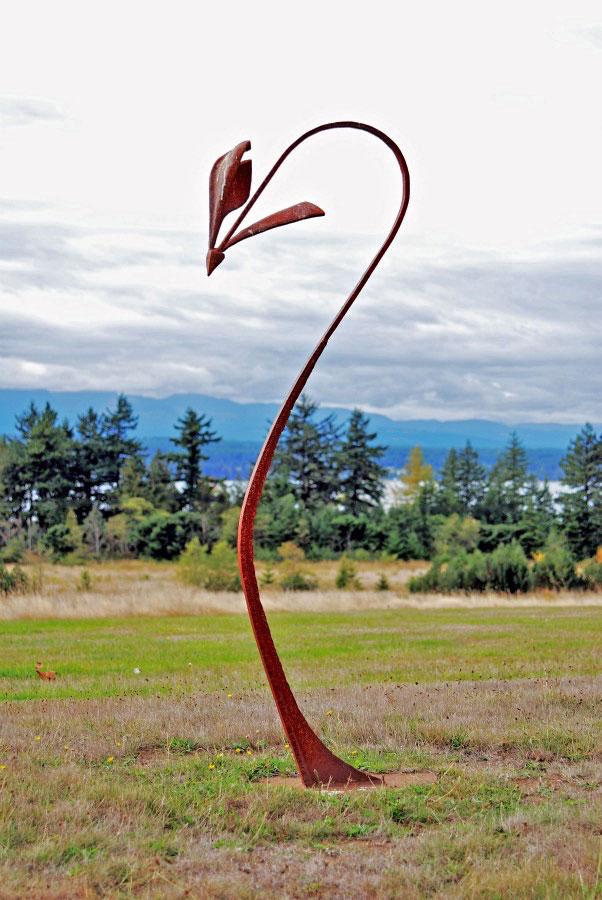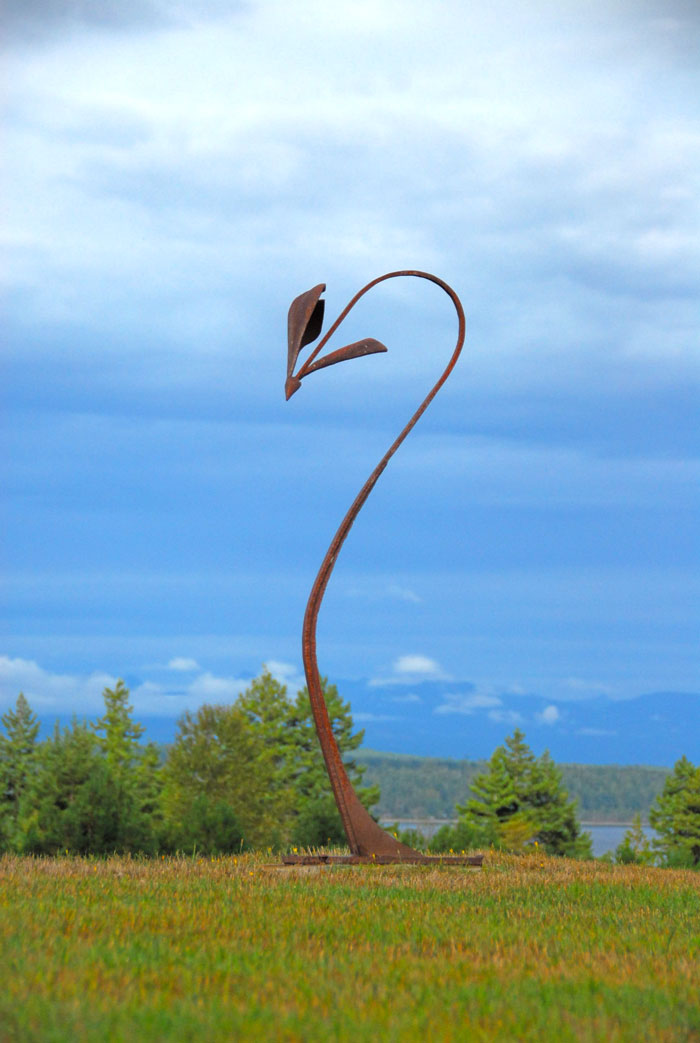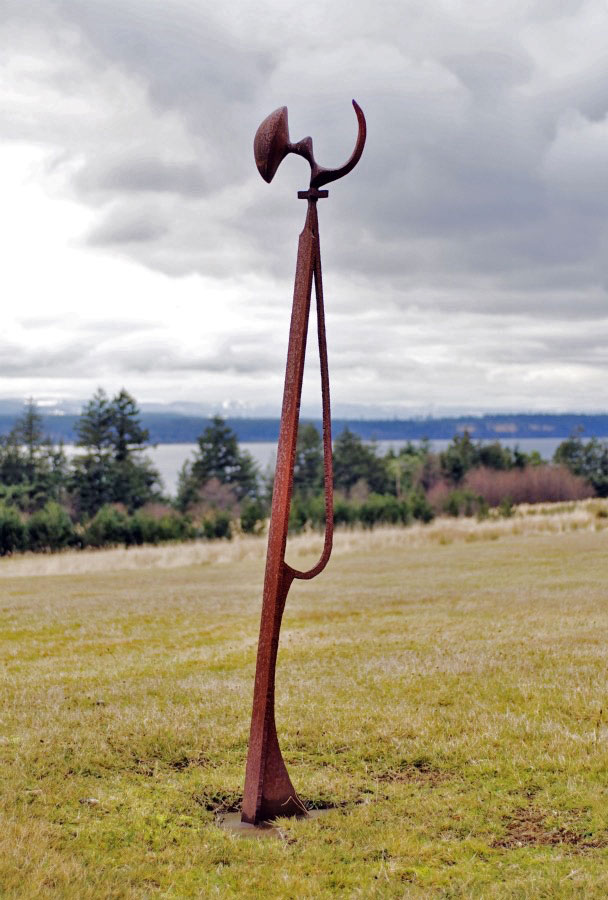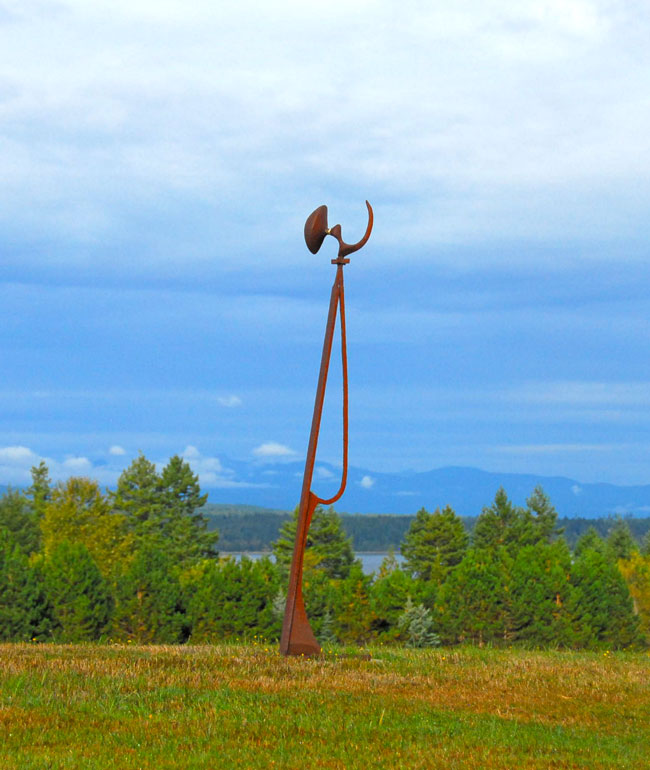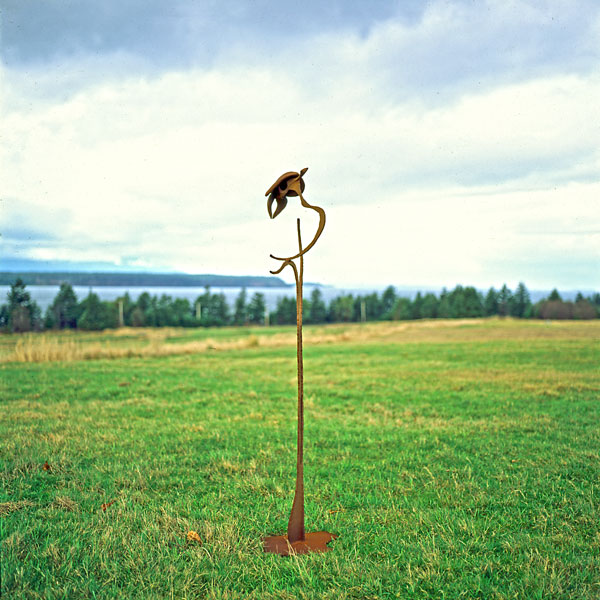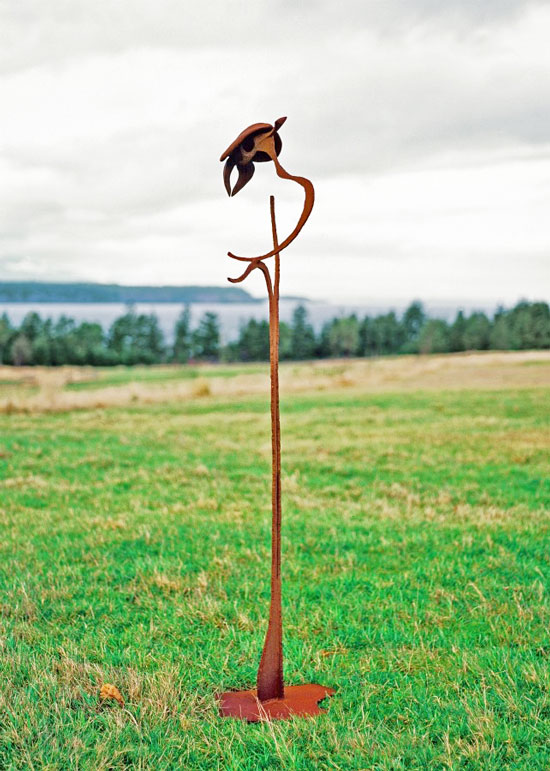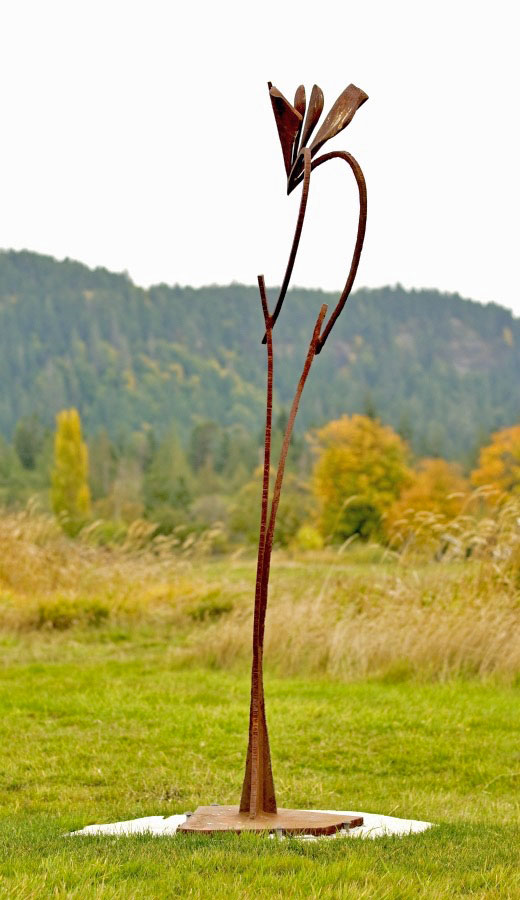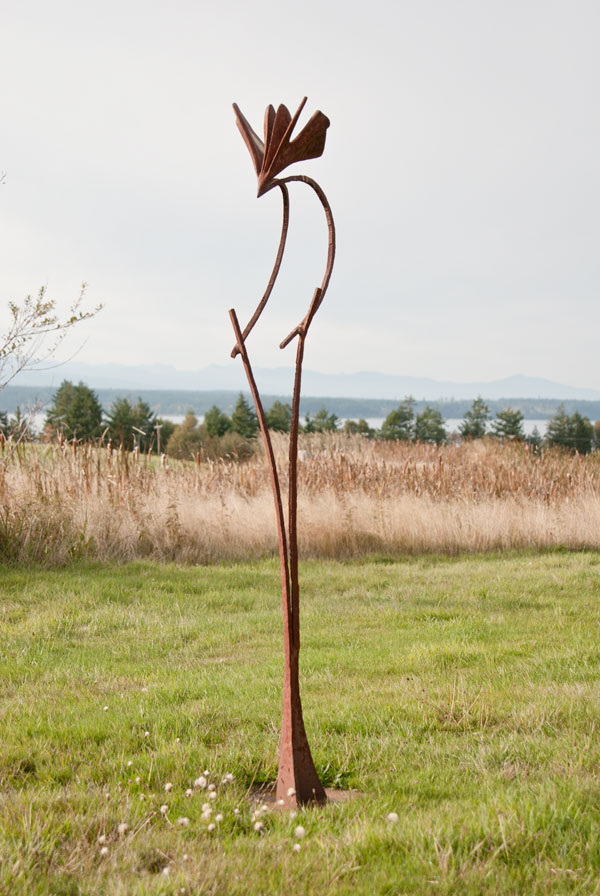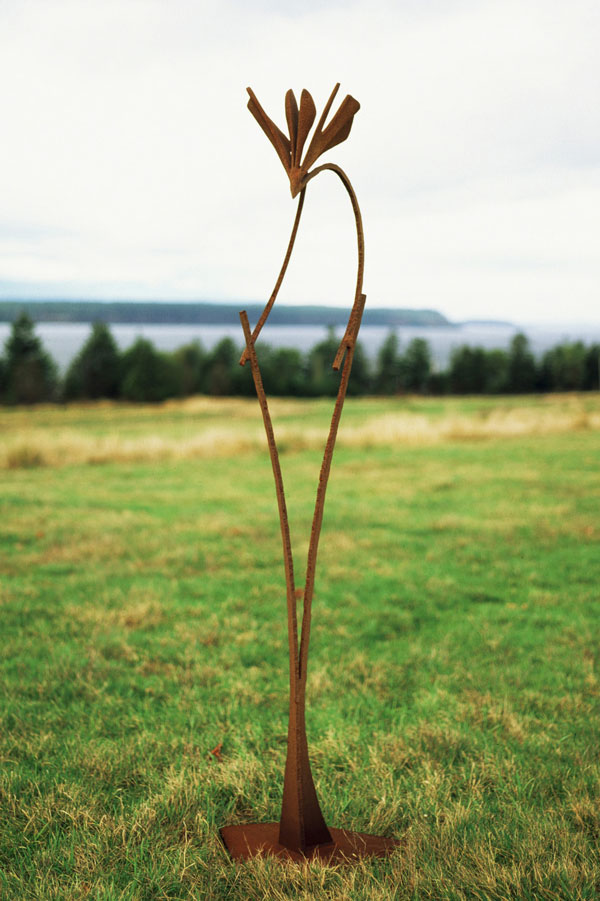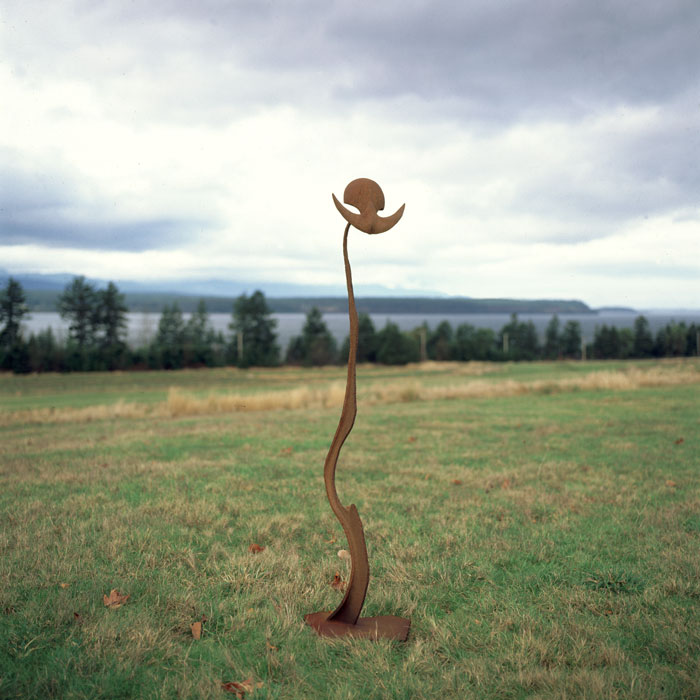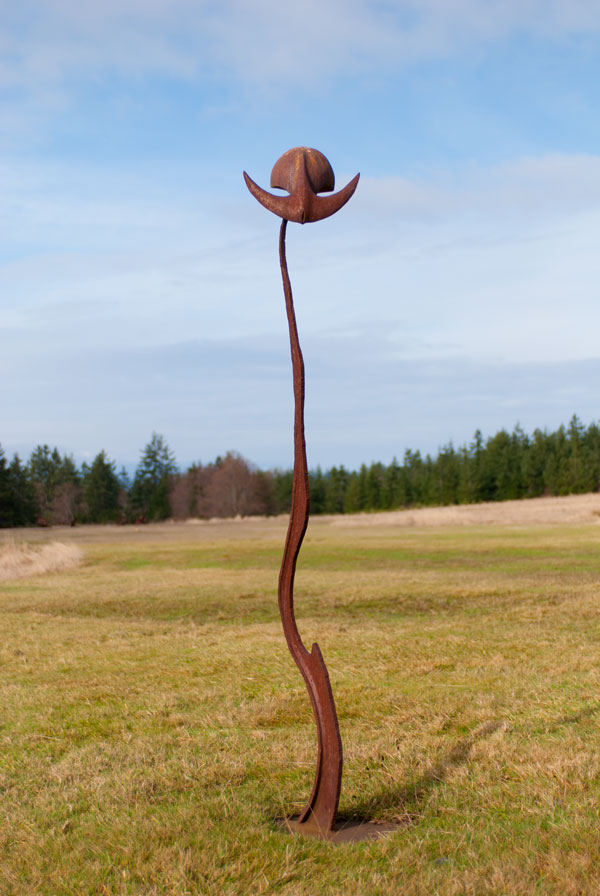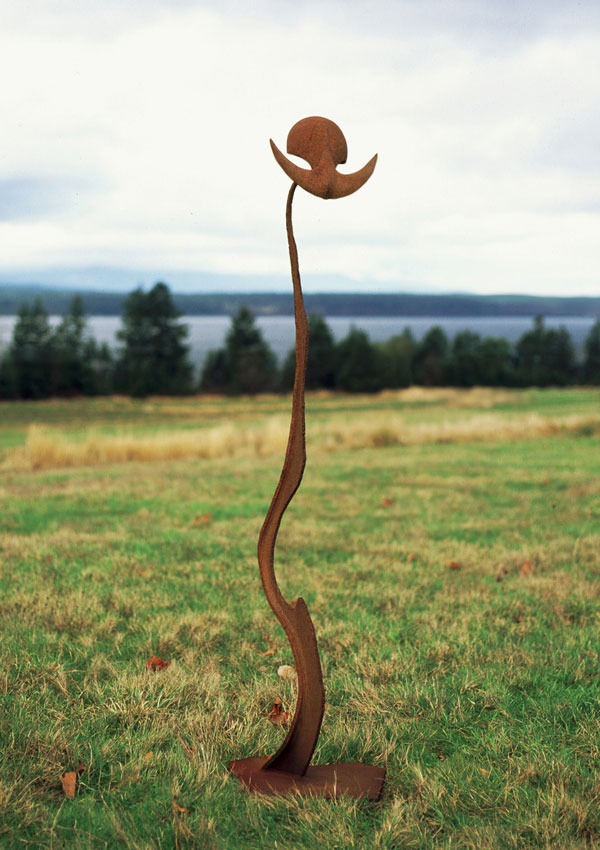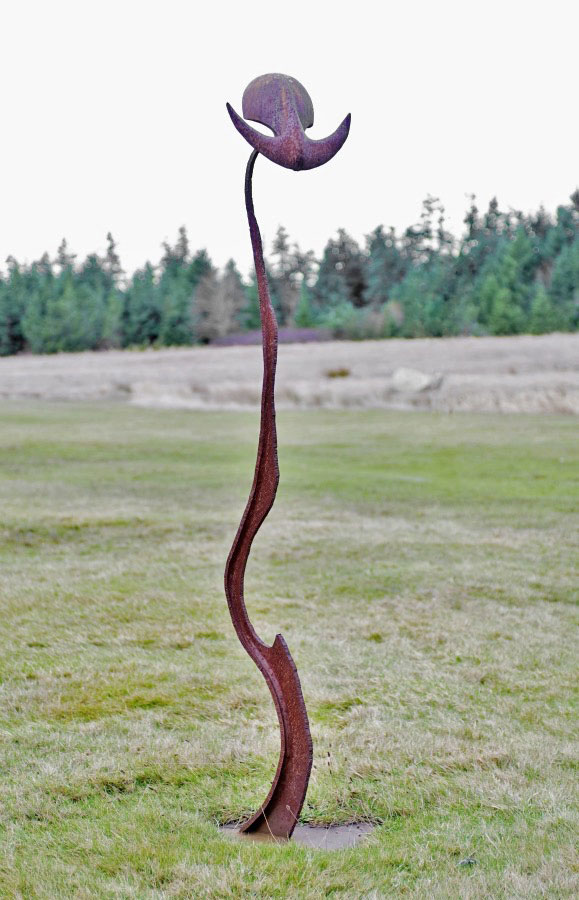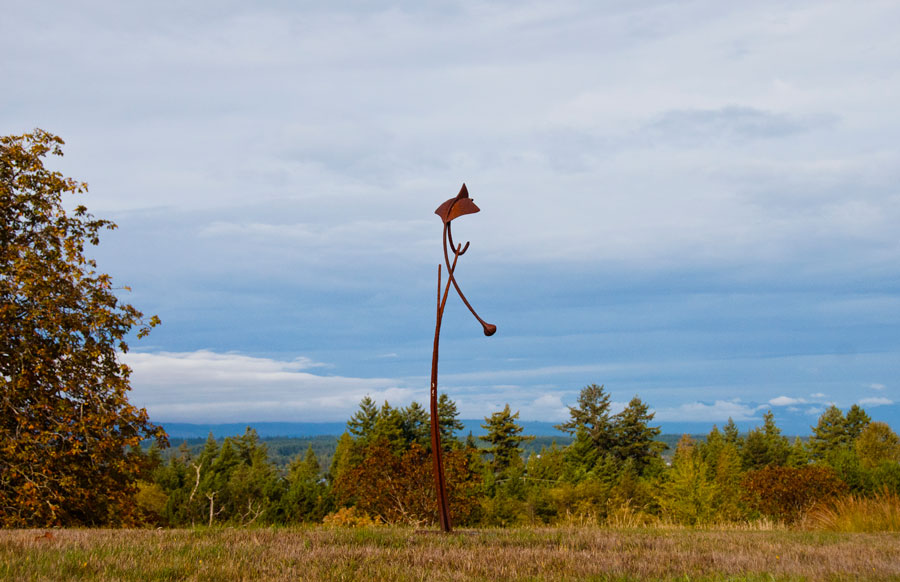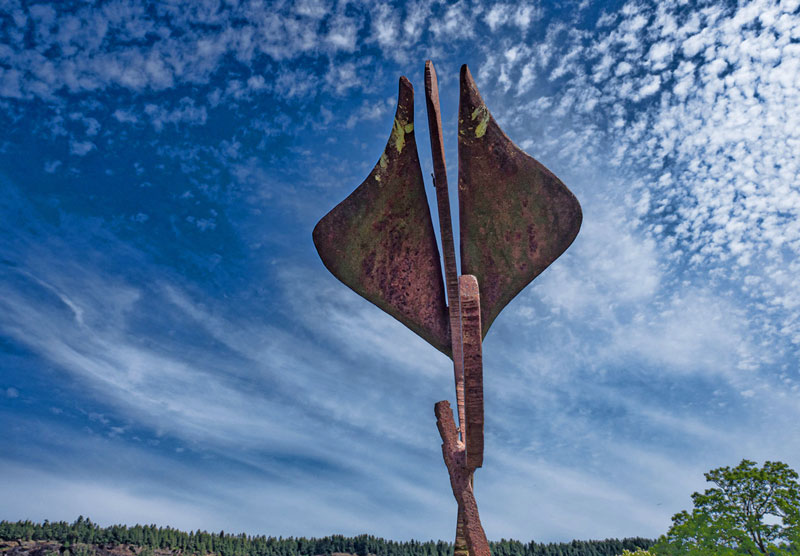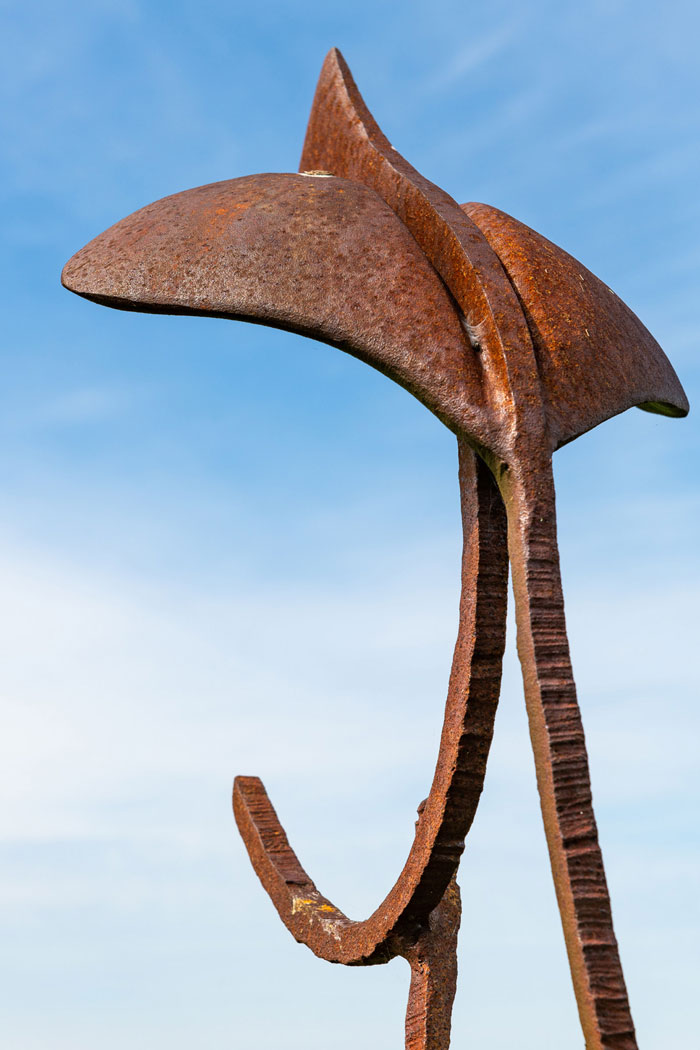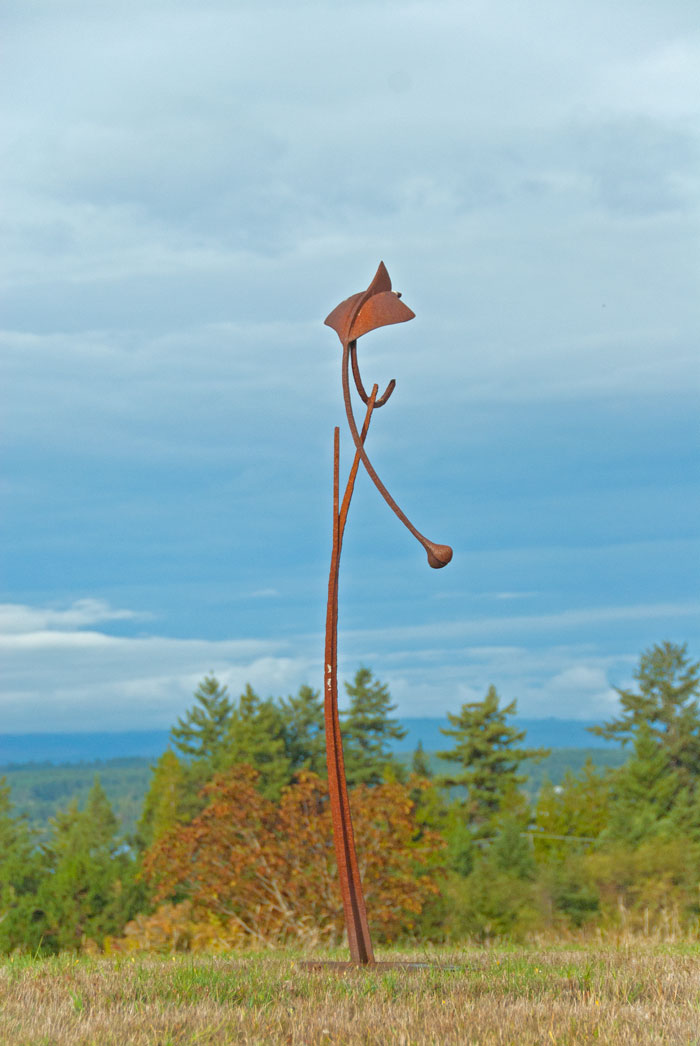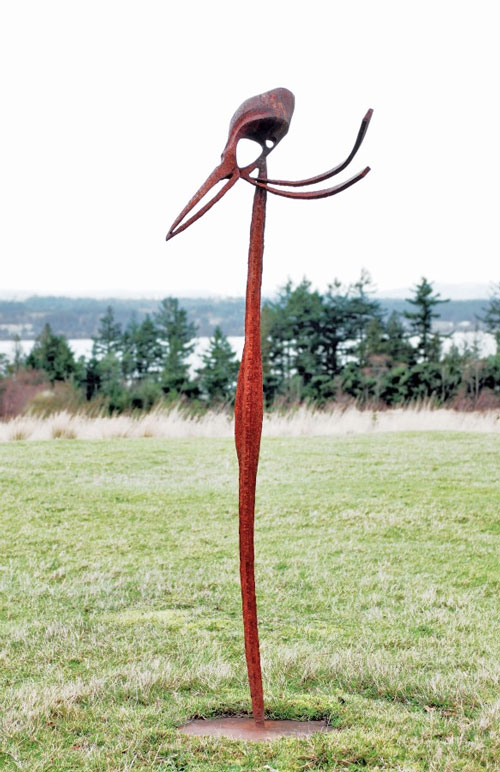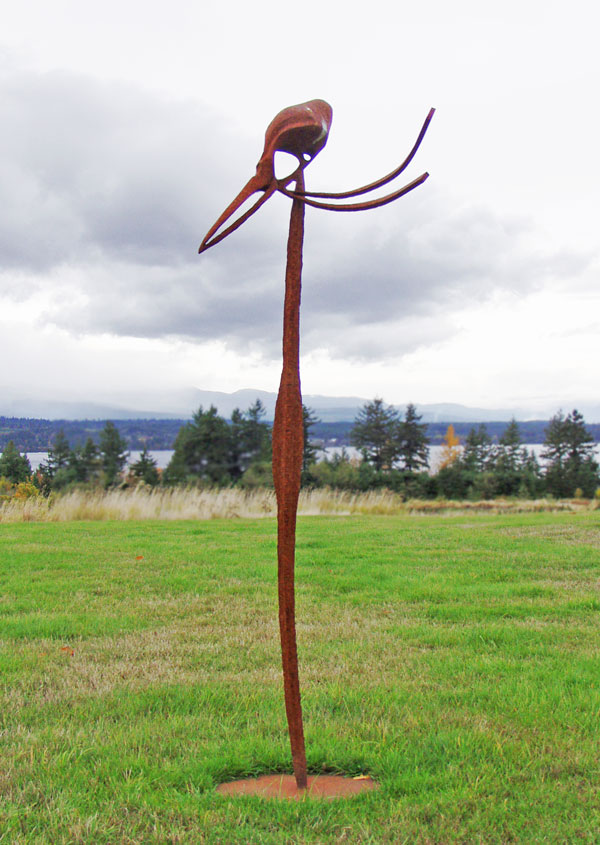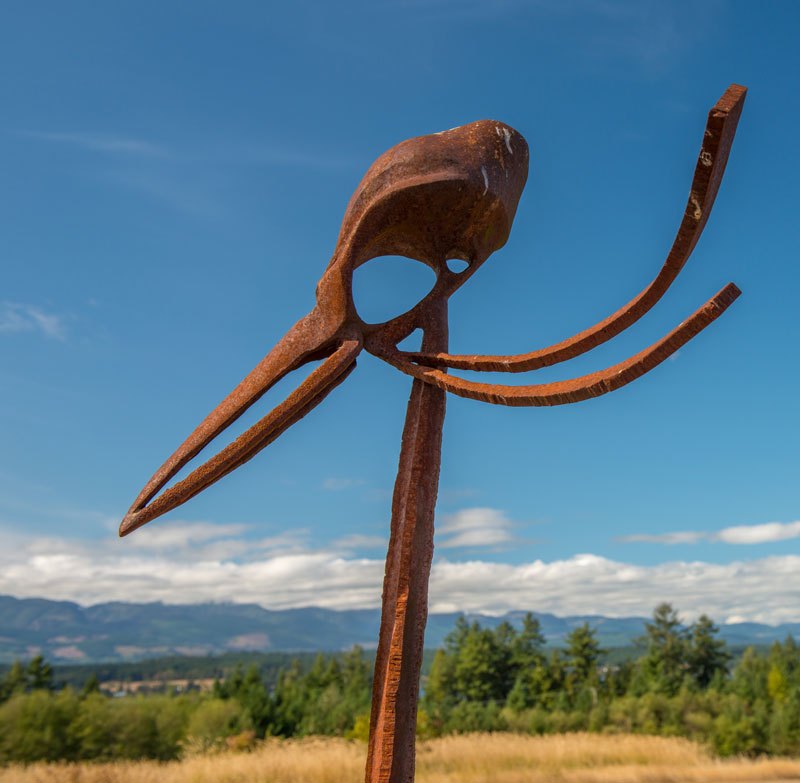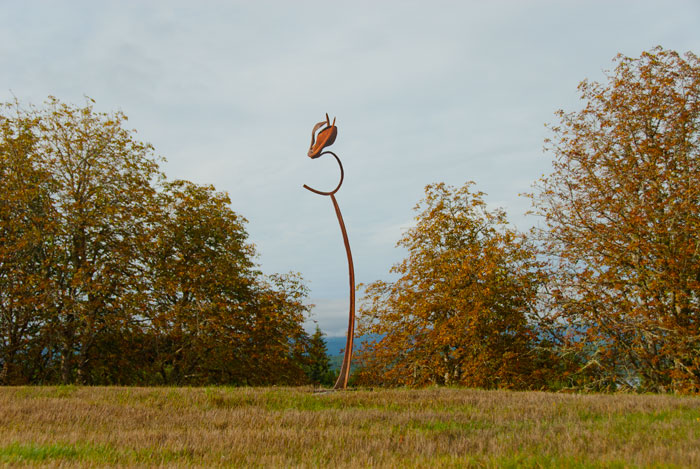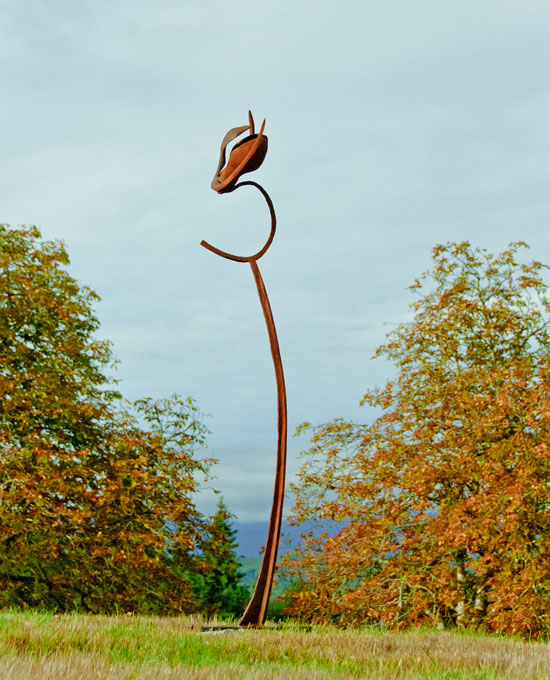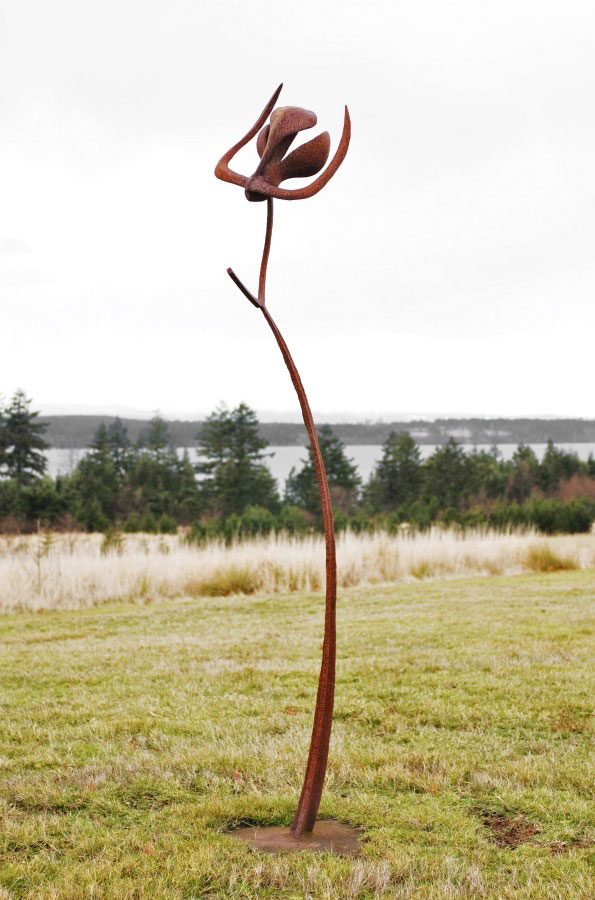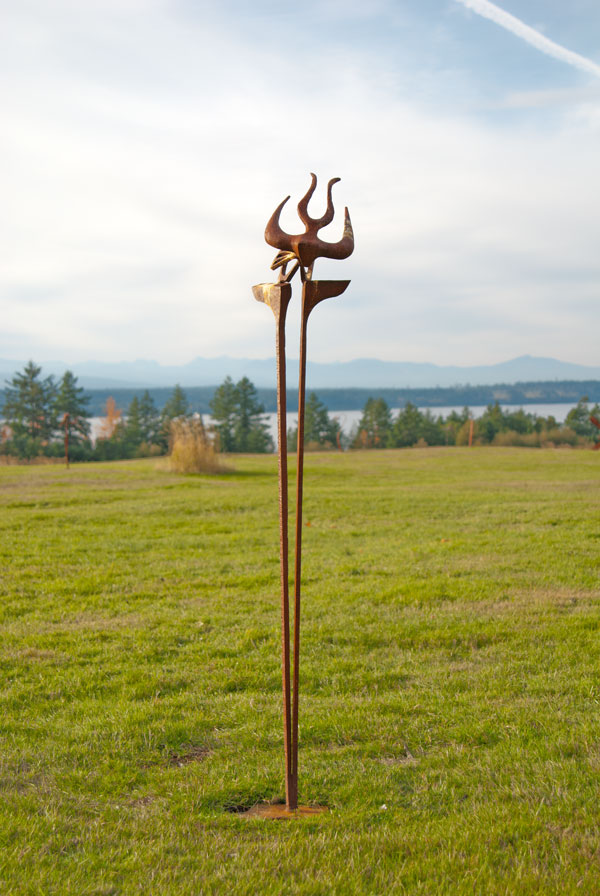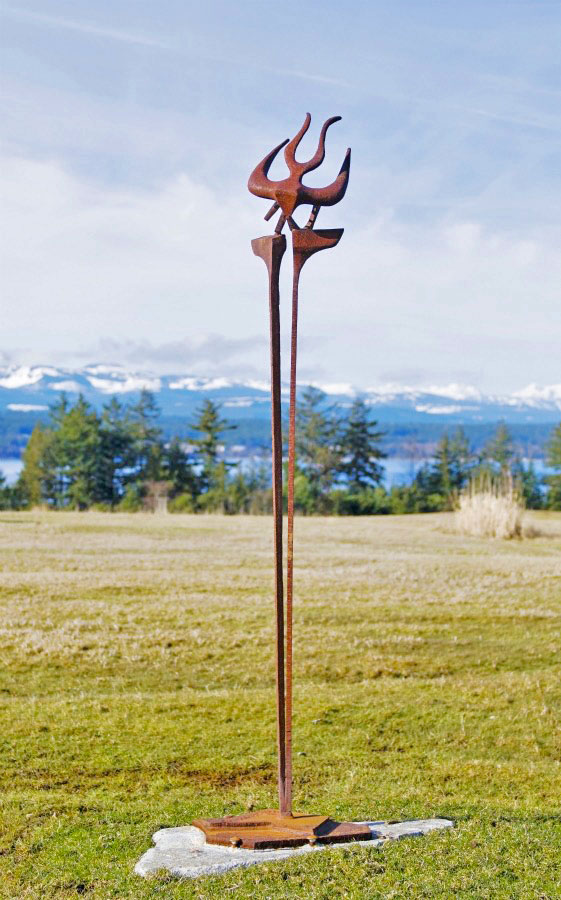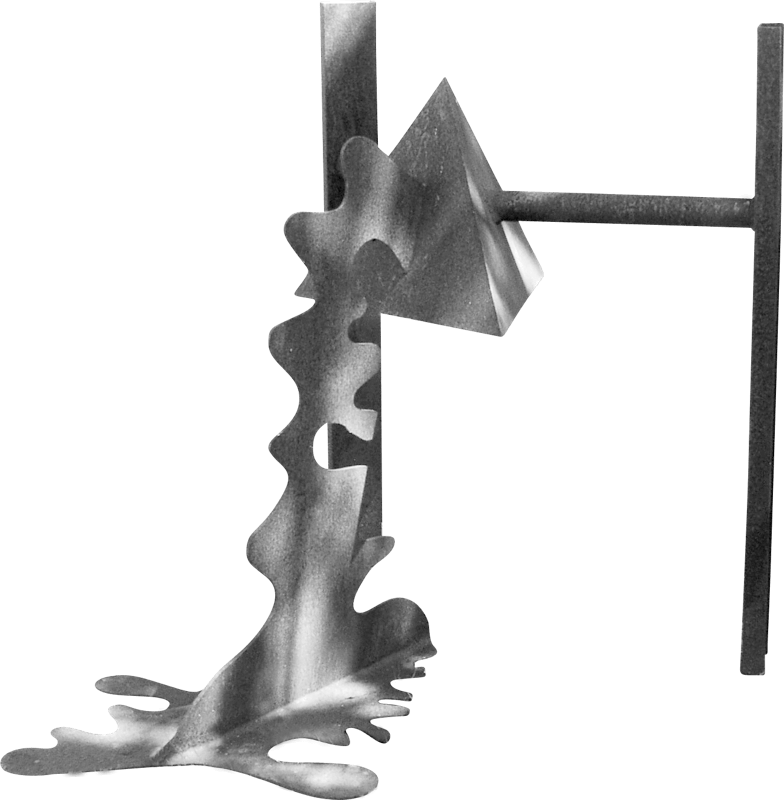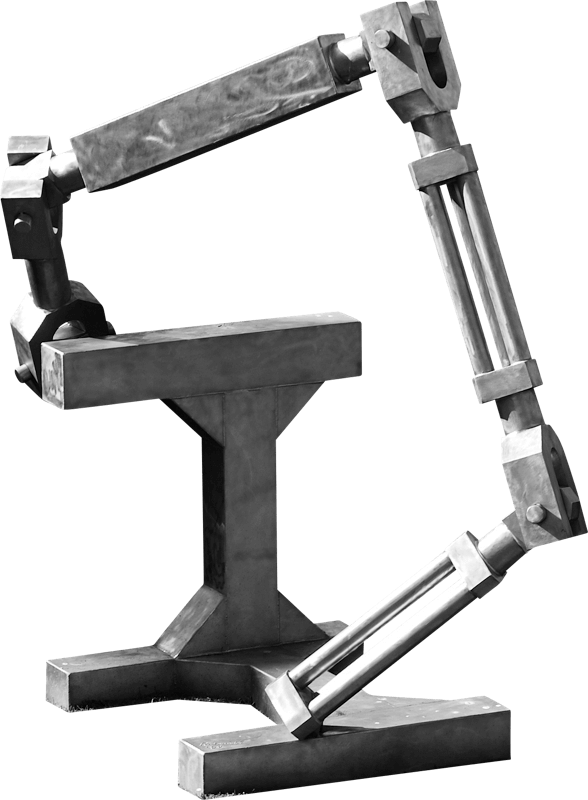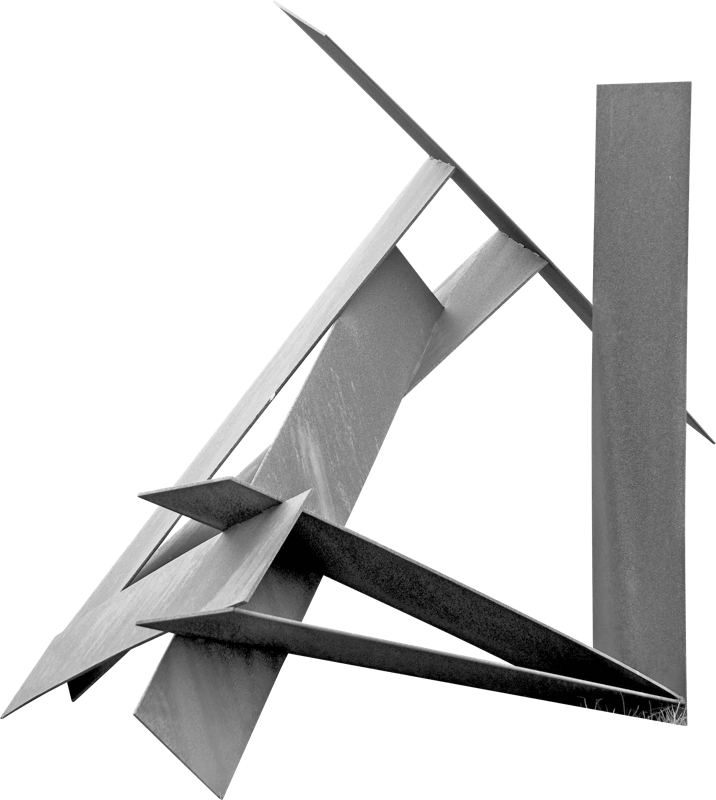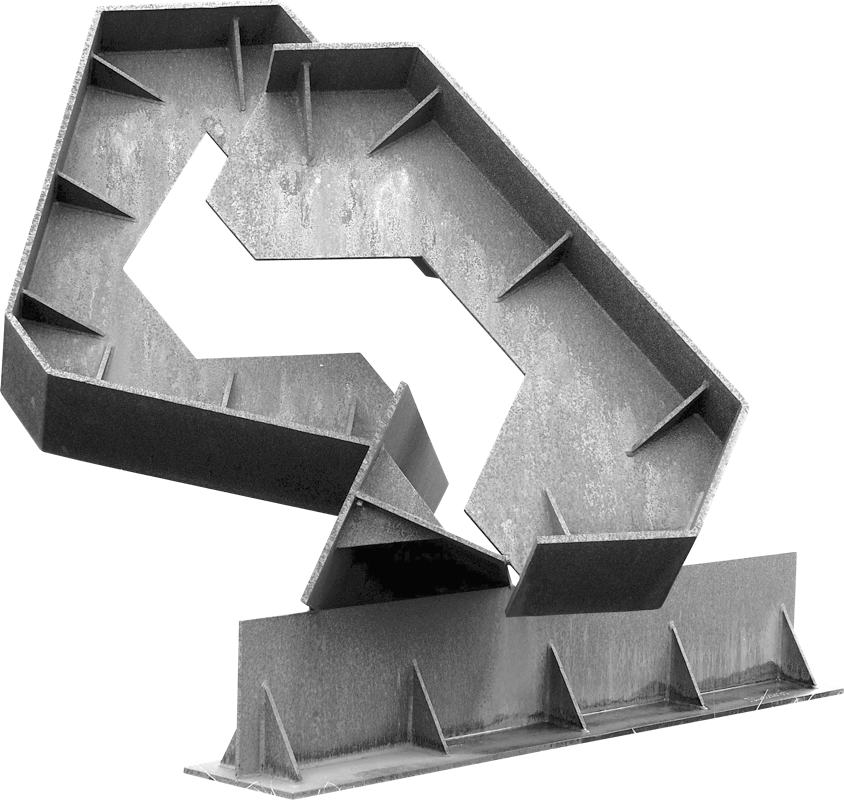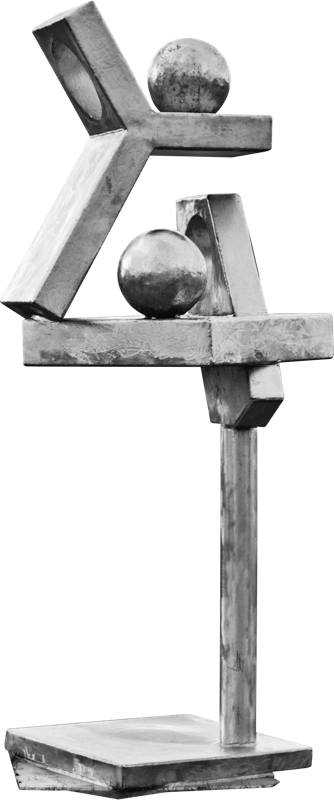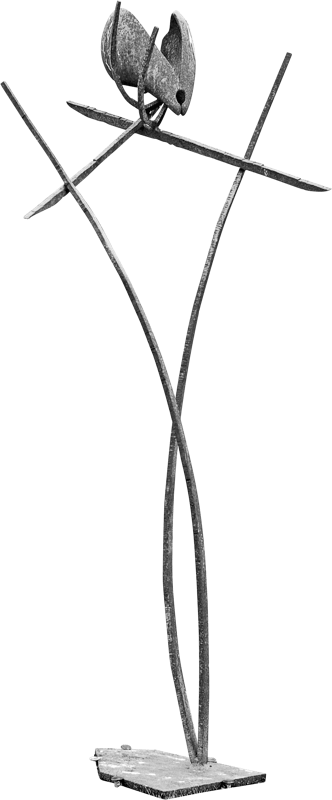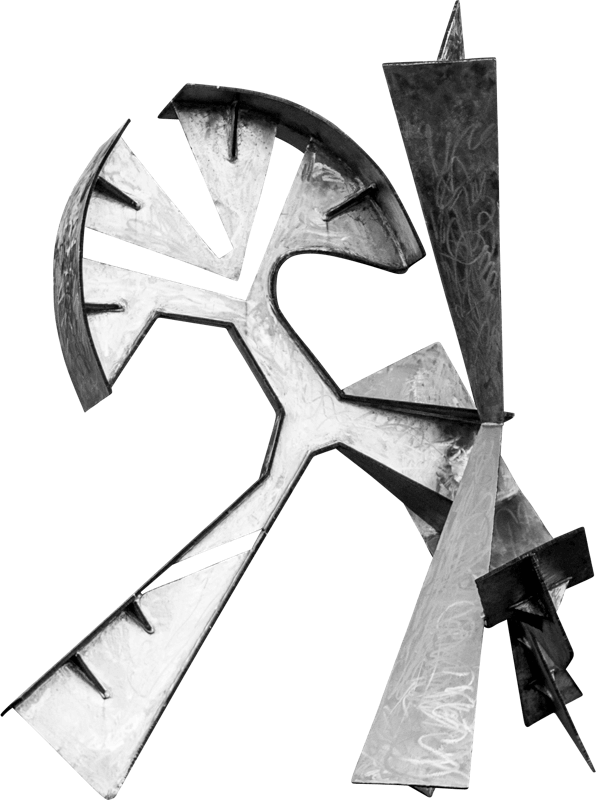Series 6
1990-96 | In 1909 the Burgess Shale Formation was discovered near the Canadian town of Field, British Columbia. The deposits contained fossils of some of the earliest recorded life on Earth, dating back 505 million years during the Cambrian period. In 1989 Rubinoff became fascinated by the deposits, as well as by the larger process of evolution. The sculptures of Series 6, which Rubinoff made over an extended period of six years, draw on the fossilized forms found in the Burgess Shale, and reflect on the relationship between natural history and art history. “The meaning of the Burgess Shale to me”, he recalled, “established that the exploration of form and its rapid evolution with which I was involved as an artist was a phenomenon rooted in nature itself.”
Series 6-Burgess 1
Jeffrey Rubinoff
1990, A 242 Cor-ten – Casting & Welded plate,
H 6ft W 2ft L 1.5ft
This series begins with references to two major animal phyla that emerged during the Cambrian Explosion – arthropods and molluscs. Burgess 1 is supported on two gracefully arching legs that open and close as the viewer walks around them. Joined to these are a pair of contrastingly linear leg segments in a subtle reference to the jointed limbs of arthropods, whose body forms so fascinated Rubinoff. These legs support two further appendages which allude to tentacles or antennae, as well as a pair of mollusc shells enclosing two further lobes which could be interpreted as gills.
This series begins with references to two major animal phyla that emerged during the Cambrian Explosion – arthropods and molluscs. Burgess 1 is supported on two gracefully arching legs that open and close as the viewer walks around them. Joined to these are a pair of contrastingly linear leg segments in a subtle reference to the jointed limbs of arthropods, whose body forms so fascinated Rubinoff. These legs support two further appendages which allude to tentacles or antennae, as well as a pair of mollusc shells enclosing two further lobes which could be interpreted as gills.
Series 6-Burgess 2
Jeffrey Rubinoff
1990, A 242 Cor-ten – Casting & Welded plate,
H 6ft W 1.5ft L 1ft
Series 6-Burgess 2
Jeffrey Rubinoff
1990, A 242 Cor-ten – Casting & Welded plate,
H 6ft W 1.5ft L 1ft
In this piece Rubinoff switches to a monopod leg structure, which splits into two: one part twists around itself and bends back towards the center of gravity to support the body of the sculpture, while the other continues curving upwards. Rubinoff expands the series’ formal vocabulary by referencing the chordate phylum: another evolutionary milestone of the Cambrian Explosion. Two bone-like masses mirror each other, one of which terminates in an axe-head. The motif will occur repeatedly throughout the series. At the intersections of the bony masses a pair of arthropod gill appendages open up like flowers.
Series 6-Cassiopeia 1
Jeffrey Rubinoff
1990, A 242 Cor-ten – Casting & Welded plate,
H 6ft W 1ft L 1ft
The most prominent feature in the first work of the Cassiopeia subseries is the central bone-like mass, which implies the orbit of an eye and gives the sculpture the impression of having a face or head. Rubinoff continues the use of the half-inch plate for the leg segments. Cassiopeia 1’s V-shaped legs are capped with adjoining ray-like segments, one of which terminates in an axe-head — a form that will be used throughout Series 6. The ray-like segments are set at diagonal opposing angles to an X-shaped bone structure located behind the central face. This juxtaposition creates a distinctive visual dynamism and impression of forward motion.
The most prominent feature in the first work of the Cassiopeia subseries is the central bone-like mass, which implies the orbit of an eye and gives the sculpture the impression of having a face or head. Rubinoff continues the use of the half-inch plate for the leg segments. Cassiopeia 1’s V-shaped legs are capped with adjoining ray-like segments, one of which terminates in an axe-head — a form that will be used throughout Series 6. The ray-like segments are set at diagonal opposing angles to an X-shaped bone structure located behind the central face. This juxtaposition creates a distinctive visual dynamism and impression of forward motion.
Series 6-Cassiopeia 2
Jeffrey Rubinoff
1991, A 242 Cor-ten – Casting & Welded plate,
H 6ft W 1ft L 1ft
Series 6-Cassiopeia 2
Jeffrey Rubinoff
1991, A 242 Cor-ten – Casting & Welded plate,
H 6ft W 1ft L 1ft
Ascending from a single point, the legs of Cassiopeia 2 bifurcate into two opposing graceful arcs, connecting again to outline a lens-shaped negative space between them. A semicircular leg segment projects outward, which, combined with the two other curved bone segments circumscribes a twisted interior volume. This trio of curves is set in counterpoint with another trio, namely the negative semicircles cut out of the carapace at the apex of the work. The axe-head once again reappears, accentuating the evolutionary connection to this sculpture’s immediate predecessor, combining a human technological form with that of a 500 million-year-old animal body.
Series 6-Cassiopeia 3
Jeffrey Rubinoff
1991, A 242 Cor-ten – Casting & Welded plate,
H 6ft W 1ft L 1ft
The third work in the Cassiopeia subseries returns to the V-shaped ascending bipedal legs of Cassiopeia 1, with one terminating in a cross-shaped bone mass, and the other unattached, just below its ‘head’. Two curved appendages emanate from the cross-shaped mass, one pointing down, the other upward, echoing each other in inverse counterpoint. The ‘head’ of the work is comprised of a mushroom-shaped hollow carapace which sits atop a complex bone shape. From various angles, the curves of both carapace and bone volumes refer to one another by imitation and inversion but appear unified into a seamless flowing form.
The third work in the Cassiopeia subseries returns to the V-shaped ascending bipedal legs of Cassiopeia 1, with one terminating in a cross-shaped bone mass, and the other unattached, just below its ‘head’. Two curved appendages emanate from the cross-shaped mass, one pointing down, the other upward, echoing each other in inverse counterpoint. The ‘head’ of the work is comprised of a mushroom-shaped hollow carapace which sits atop a complex bone shape. From various angles, the curves of both carapace and bone volumes refer to one another by imitation and inversion but appear unified into a seamless flowing form.
Series 6-Cassiopeia 4
Jeffrey Rubinoff
1991, A 242 Cor-ten – Casting & Welded plate,
H 6ft W 1ft L 1ft
Series 6-Cassiopeia 4
Jeffrey Rubinoff
1991, A 242 Cor-ten – Casting & Welded plate,
H 6ft W 1ft L 1ft
Like the second sculpture in the Cassiopeia subseries, the fourth piece employs a similar leg arrangement, which beautifully circumscribes a lens shape in negative space. The legs terminate into a central point and on to a pair of laterally inverted bone masses. This pair of forms work in counterpoint to the cephalopodic tentacles atop them. Again as elsewhere in this series, Rubinoff combines body forms from cephalopods, arthropods, and vertebrates, all of which are animal phyla that emerged during the Cambrian Explosion. From one angle this figure seems to be looking at the viewer with outstretched arms.
Series 6-Cassiopeia 5
Jeffrey Rubinoff
1991, A 242 Cor-ten – Casting & Welded plate,
H 6ft W 2ft L 1ft
The fifth Cassiopeia sculpture employs a diagonal tail segment, which curves in a whip-like gesture down from the head. The head itself looks to be an arthropodic carapace split laterally by a central void. Its underside has a grooved pattern, giving the impression of a mollusc or brachiopod shell. The side view of the head reveals a trio of curves in negative space, delineated gracefully by the boney mass. Viewed from the front, both the central cleft in the head and the tail share a singular angle, which is rotated about 15 degrees from vertical. The main sculptural forms allude both to spermatozoa and a vulva, perhaps indicating the artist’s intention to symbolize creative reproduction.
The fifth Cassiopeia sculpture employs a diagonal tail segment, which curves in a whip-like gesture down from the head. The head itself looks to be an arthropodic carapace split laterally by a central void. Its underside has a grooved pattern, giving the impression of a mollusc or brachiopod shell. The side view of the head reveals a trio of curves in negative space, delineated gracefully by the boney mass. Viewed from the front, both the central cleft in the head and the tail share a singular angle, which is rotated about 15 degrees from vertical. The main sculptural forms allude both to spermatozoa and a vulva, perhaps indicating the artist’s intention to symbolize creative reproduction.
Series 6-Cassiopeia 6
Jeffrey Rubinoff
1990, A 242 Cor-ten – Casting & Welded plate,
H 6ft W 1ft L 1ft
Series 6-Cassiopeia 6
Jeffrey Rubinoff
1990, A 242 Cor-ten – Casting & Welded plate,
H 6ft W 1ft L 1ft
The legs of Cassiopeia 6 are formed of complex curves bent in multiple places in a gesture implying bent knees. For the first time in the Cassiopeia subseries, the bipedal legs are arranged in a spiral formation. Commanding immediate attention are three lobe-like masses, two pointing up and the other down – all at the same 15-degree angle. A pair of curved arthropod leg segments pick up where the lower spiral leg segments leave off. The sculpture’s head is completed with a pair of mollusc shells, imitating each other’s form, with one double the size of the other. This sculpture’s bulbous forms are somewhat unusual compared to the jagged shapes that characterize the rest of Series 6.
Series 6-Cassiopeia 8
Jeffrey Rubinoff
1991, A 242 Cor-ten – Casting & Welded plate,
H 6ft W 1ft L 1ft
Cassiopeia 8 uses forms highly reminiscent of phalanges (finger and toe bones). The sculpture is supported on a bipedal base; one leg thrusts straight upwards while the other projects out at an obtuse angle from a short horizontal bar. The body of the piece is made up of a central collection of bone masses that resemble the bones of a finger, pushing out from one of the points of an antler-like bifurcated bone mass. At the bulbous top of the antler form the axe-head attaches itself with a socket. The body and head curve around a vertical axis, enclosing a roughly spherical negative space.
Cassiopeia 8 uses forms highly reminiscent of phalanges (finger and toe bones). The sculpture is supported on a bipedal base; one leg thrusts straight upwards while the other projects out at an obtuse angle from a short horizontal bar. The body of the piece is made up of a central collection of bone masses that resemble the bones of a finger, pushing out from one of the points of an antler-like bifurcated bone mass. At the bulbous top of the antler form the axe-head attaches itself with a socket. The body and head curve around a vertical axis, enclosing a roughly spherical negative space.
Series 6-Cassiopeia 9
Jeffrey Rubinoff
1991, A 242 Cor-ten – Casting & Welded plate,
H 6ft W 1.5ft L 1ft
Series 6-Cassiopeia 9
Jeffrey Rubinoff
1991, A 242 Cor-ten – Casting & Welded plate,
H 6ft W 1.5ft L 1ft
The head of the ninth Cassiopeia sculpture incorporates another antler-like bone mass, emanating from arthropod carapace, which itself rests on an axe-head form. It is supported by a tripedal leg arrangement, one of which has a secondary segment emphasizing the jointed appendages of arthropods. The order of complexity of the base and head is well paired, making the piece feel spatially balanced rather than top-heavy. The bilaterally symmetrical carapace gestures towards wings, while the arch created by the gentle upward thrust of the antler segment adds to the sense of movement and flight in the piece. As with Cassiopeia 5, the reference to vulva shape is indicated by the central cleft in the arthropod carapace.
Series 6-Cassiopeia 10
Jeffrey Rubinoff
1992, A 242 Cor-ten – Casting & Welded plate,
H 6.5ft W 1.5ft L 1ft
Cassiopeia 10 has the unique feature of ‘feet’. Rising from these jagged feet are two thin parallel legs, one of which bends before terminating in space. The main double-lobed bone mass head is tethered to a double-wing structure by a pair of cephalopod tentacles, which conjoin and rise into an arrowhead-shaped upward-pointing void. This arrowhead vectors into a vertical vulva-like indentation in the convex side of the arthropodic carapace head form.
Cassiopeia 10 has the unique feature of ‘feet’. Rising from these jagged feet are two thin parallel legs, one of which bends before terminating in space. The main double-lobed bone mass head is tethered to a double-wing structure by a pair of cephalopod tentacles, which conjoin and rise into an arrowhead-shaped upward-pointing void. This arrowhead vectors into a vertical vulva-like indentation in the convex side of the arthropodic carapace head form.
Series 6-Cleo 2
Jeffrey Rubinoff
1990, A 242 Cor-ten – Casting & Welded plate,
H 6ft W 5.5ft L 5.5ft
Series 6-Cleo 2
Jeffrey Rubinoff
1990, A 242 Cor-ten – Casting & Welded plate,
H 6ft W 5.5ft L 5.5ft
In the Cleo subseries, Rubinoff explores the possibilities of less explicitly animal organic forms. The second piece is the first sculpture that was actually made, with Cleo 1 having likely been discarded in the design stage. Rubinoff worked on only one sculpture at a time, incrementally adapting their forms in an evolutionary fashion. With Cleo 2 Rubinoff retains a nod to the leggy organisms of the Burgess subseries, but introduces the sphere which was so ubiquitous in Series 5. Here two quarter-spheres float upon a backwards leaning leg, its form echoing the bulrushes in the pond just beyond. Just below the semispherical head, a pair of gently curved legs connect with their straight counterpart to form a tripod.
Series 6-Cleo 4
Jeffrey Rubinoff
1990, A 242 Cor-ten – Casting & Welded plate,
H 6ft W 2ft L 2ft
For Cleo 4, Rubinoff shifts from half-inch to one-inch plate to fabricate the legs and appendages. Thrusting up in bold parallel lines, a pair of ruler-straight legs connect to identical arcs which themselves sweep up to a point. They also define a hemispheric void in which a trio of ray-like appendages connect, weaving in and out of the other elements of the piece. The sculpture reintroduces animal shapes from the chordate phylum, this time the bone mass taking a complex vertebral form, which is crowned by a sphere. The use of the heavy plate creates a tension between powerful upward motion and the visible weight of the piece.
For Cleo 4, Rubinoff shifts from half-inch to one-inch plate to fabricate the legs and appendages. Thrusting up in bold parallel lines, a pair of ruler-straight legs connect to identical arcs which themselves sweep up to a point. They also define a hemispheric void in which a trio of ray-like appendages connect, weaving in and out of the other elements of the piece. The sculpture reintroduces animal shapes from the chordate phylum, this time the bone mass taking a complex vertebral form, which is crowned by a sphere. The use of the heavy plate creates a tension between powerful upward motion and the visible weight of the piece.
Series 6-Cleo 5
Jeffrey Rubinoff
1990, A 242 Cor-ten – Casting & Welded plate,
H 6ft W 2.5ft L 2ft
Series 6-Cleo 5
Jeffrey Rubinoff
1990, A 242 Cor-ten – Casting & Welded plate,
H 6ft W 2.5ft L 2ft
What strikes the viewer first about Cleo 5 is Rubinoff’s introduction of a pair of wing-like structures, one with a lattice pattern and the other fabricated of half-inch plate, both terminating in a two-thirds sphere. Also connected to that point of focus is a pair of curved arthropodic antennae appendages. This group of five elements forms an impression of upward flight, perhaps of an insect. At the tip of the latticed wing, the creature is attached to an angular plate, the vertex pointing away from the organic forms. The base of this sculpture is a tripod with a bisected metal base, one of which has a foot segment; a motif unique to this sculpture.
Series 6-Xeno 1
Jeffrey Rubinoff
1990, A 242 Cor-ten – Casting & Welded plate,
H 6ft W 1ft L 1ft
Notable about the Xeno subseries is the move back to arthropod forms. Xeno 1 has a dome-like carapace elegantly flowing into a tentacle appendage. The tentacle curls back into itself and restates the carapace form in negative space. It is attached to a cross-shaped bone mass. As with Cleo 4, the legs are parallel lines with an almost imperceptible tilt to one side. Another notable feature is the lack of imitative counterpoint in the forms; only the two legs give the viewer a sense of symmetry.
Notable about the Xeno subseries is the move back to arthropod forms. Xeno 1 has a dome-like carapace elegantly flowing into a tentacle appendage. The tentacle curls back into itself and restates the carapace form in negative space. It is attached to a cross-shaped bone mass. As with Cleo 4, the legs are parallel lines with an almost imperceptible tilt to one side. Another notable feature is the lack of imitative counterpoint in the forms; only the two legs give the viewer a sense of symmetry.
Series 6-Xeno 2
Jeffrey Rubinoff
1990, A 242 Cor-ten – Casting & Welded plate,
H 7ft W 1.5ft L 1ft
Series 6-Xeno 2
Jeffrey Rubinoff
1990, A 242 Cor-ten – Casting & Welded plate,
H 7ft W 1.5ft L 1ft
Xeno 2 features a highly dramatic contrast between a pair of jagged, disordered fabricated shards and a pair of graceful, bulbous cast shapes forming the head of the composition. This visual disjunction of organic and industrial forms creates a sense of unease. As in Xeno 1, Rubinoff seamlessly blends the carapace body forms of arthropods with the bone mass shapes of vertebrates. Of additional interest is the quadrupedal leg which terminates at the base plate in a bulb shape, creating an elongated teardrop with a definite upward motion. As with all of Rubinoff’s work after Series 1, this sculpture has a rising gesture, mirroring the upward motion of the plants, trees, and mountains around the Sculpture Park.
Series 6-Xeno 3
Jeffrey Rubinoff
1991, A 242 Cor-ten – Casting & Welded plate,
H 6.5ft W 1ft L 1ft
In marked contrast to its immediate predecessor, Xeno 3 exudes unity and elegance. The most prominent element is a tear-shaped arthropod carapace on the back of which we find a smaller repeated teardrop cutout in negative space. At the tip of the drop a protrusion forms a semicircular arc, itself circumscribing a void reminiscent of the curves in the teardrop. This curve is simply an elegant extension of the teardrop form, and is echoed twice more in similar curves at various angles. The legs of the sculpture begin in a singular motion, bifurcating into a knee and an elbow, and terminating with a wing-shaped bone structure that supports the head.
In marked contrast to its immediate predecessor, Xeno 3 exudes unity and elegance. The most prominent element is a tear-shaped arthropod carapace on the back of which we find a smaller repeated teardrop cutout in negative space. At the tip of the drop a protrusion forms a semicircular arc, itself circumscribing a void reminiscent of the curves in the teardrop. This curve is simply an elegant extension of the teardrop form, and is echoed twice more in similar curves at various angles. The legs of the sculpture begin in a singular motion, bifurcating into a knee and an elbow, and terminating with a wing-shaped bone structure that supports the head.
Series 6-Xeno 4
Jeffrey Rubinoff
1991, A 242 Cor-ten – Casting & Welded plate,
H 6ft W 1ft L 1ft
Series 6-Xeno 4
Jeffrey Rubinoff
1991, A 242 Cor-ten – Casting & Welded plate,
H 6ft W 1ft L 1ft
The most prominent feature of Xeno 4 is the amorphous composition of the sculpture’s head. Alluding to hip bones, the head is composed of a pair of bone masses perforated with oval void spaces. These do not relate to each other or any other part of the sculpture, but meld into a semicircular trunk-like appendage, which likewise doesn’t relate to any of the other bone mass features. As in Cleo 4, a trio of ray-like appendages supports the body and connects to a simple bifurcated leg. The legs are thrust upward but also have a pronounced lateral lean. Overall the appearance of the sculpture shifts dramatically from the side to the front, and most of its volumes do not find a reference in the catalogue of Rubinoff’s commonly used animal forms.
Series 6-Xeno 5
Jeffrey Rubinoff
1991, A 242 Cor-ten – Casting & Welded plate,
H 7ft W 1ft L 1ft
In a return to the helix form of Burgess 1, the bipedal legs of Xeno 5 flow gracefully into its crowning pair of arthropod antennae. One upward thrusting leg remains gracefully swept back, whereas the other spirals around it. As the viewer walks around the piece, the curves of the antennae mimic the curves in the spiraled leg in a masterful contrapuntal composition. The head of the piece bears resemblance to a pair of multifaceted insect eyes, which upon closer examination may also be seen as a pair of mollusc shells. In striking contrast to its direct predecessor, the piece is read as rising and dancing, in a clearly joyful gesture.
In a return to the helix form of Burgess 1, the bipedal legs of Xeno 5 flow gracefully into its crowning pair of arthropod antennae. One upward thrusting leg remains gracefully swept back, whereas the other spirals around it. As the viewer walks around the piece, the curves of the antennae mimic the curves in the spiraled leg in a masterful contrapuntal composition. The head of the piece bears resemblance to a pair of multifaceted insect eyes, which upon closer examination may also be seen as a pair of mollusc shells. In striking contrast to its direct predecessor, the piece is read as rising and dancing, in a clearly joyful gesture.
Series 6-Desert Storm
Jeffrey Rubinoff
1991, A 242 Cor-ten – Casting & Welded plate,
H 6ft W 1ft L 1ft
Series 6-Desert Storm
Jeffrey Rubinoff
1991, A 242 Cor-ten – Casting & Welded plate,
H 6ft W 1ft L 1ft
Referring directly to the US military operation taking place in the year of its creation, Desert Storm is one of Rubinoff’s two war pieces. Together with the Nike of Baghdad, it is Rubinoff’s only work to focus on the destructive capacity of humanity rather than the generative and creative unfolding of life. This is made clear by the two curved axes that seem to attack eachother. As different as this work is, it reflects the same argument Rubinoff repeatedly made: that art cultivated universal human senses of awe, the sacred, and conscience, which could help the species eventually overcome the divisive narratives that so often resulted in war.
Series 6-Nike of Baghdad
Jeffrey Rubinoff
1991, A 242 Cor-ten – Casting & Welded plate,
H 6ft W 1.5ft L 1ft
Nike of Baghdad is the second war piece. Nike was the Greek goddess of victory and is typically depicted by a winged goddess. An abstracted Nike sits atop this sculpture, but Rubinoff reverses its triumphant posture, depicting the goddess as melted and deformed. The gesture of destruction is emphasized by the work’s legs, which here are bent, broken and slumped — almost like the structural steel in bombed-out buildings. Under the Nike itself is a small boney mass from which two curved arthropod antennae curve up. The Nike figure also appears to be cradled – perhaps Rubinoff’s nod to Michelangelo’s Pieta, a sculpture he greatly admired.
Nike of Baghdad is the second war piece. Nike was the Greek goddess of victory and is typically depicted by a winged goddess. An abstracted Nike sits atop this sculpture, but Rubinoff reverses its triumphant posture, depicting the goddess as melted and deformed. The gesture of destruction is emphasized by the work’s legs, which here are bent, broken and slumped — almost like the structural steel in bombed-out buildings. Under the Nike itself is a small boney mass from which two curved arthropod antennae curve up. The Nike figure also appears to be cradled – perhaps Rubinoff’s nod to Michelangelo’s Pieta, a sculpture he greatly admired.
Series 6-Andromeda 1
Jeffrey Rubinoff
1992, A 242 Cor-ten – Casting & Welded plate,
H 6ft W 1ft L 1ft
Series 6-Andromeda 1
Jeffrey Rubinoff
1992, A 242 Cor-ten – Casting & Welded plate,
H 6ft W 1ft L 1ft
The first piece in the Andromeda series is bipedal, with a straight leg that bifurcates at its top, while the other leg is made of an undulating flat plate reminiscent of Rubinoff’s early works. The body’s base is made up of a C-shape that rests on the supporting shards below, curving up to join a wavy ‘tail’ segment of half-inch plate. The head of the piece is comprised of a bulbous protrusion pointing downward, and a carapace that moves upward in opposition. Horizontal movement is implied by the wing-like gesture of carapace and gill, and by a tail that trails off into space.
Series 6-Andromeda 2
Jeffrey Rubinoff
1992, A 242 Cor-ten – Casting & Welded plate,
H 6ft W 2.5ft L 1.5ft
The head of Andromeda 2 is made up of four carapace segments, which echo each other and together mark out the space of a sphere. Two cephalopod tentacles emerge from the bottom, one gently curved, the other in a harsher ‘S’ shape. These organic forms seem to be lifting the carapace off the sculpture’s complex leg arrangement. A gently curved tentacle pushes up and off the vertical plane of a prominent angular plate form just below the head. Two other arthropodic legs do not support the head of the sculpture: one projects upward at a 45-degree angle, while the other traces a curvilinear path around it. As the viewer circumambulates the sculpture, they generate a helical motion.
The head of Andromeda 2 is made up of four carapace segments, which echo each other and together mark out the space of a sphere. Two cephalopod tentacles emerge from the bottom, one gently curved, the other in a harsher ‘S’ shape. These organic forms seem to be lifting the carapace off the sculpture’s complex leg arrangement. A gently curved tentacle pushes up and off the vertical plane of a prominent angular plate form just below the head. Two other arthropodic legs do not support the head of the sculpture: one projects upward at a 45-degree angle, while the other traces a curvilinear path around it. As the viewer circumambulates the sculpture, they generate a helical motion.
Series 6-Andromeda 3
Jeffrey Rubinoff
1993, A 242 Cor-ten – Casting & Welded plate,
H 6ft W 2ft L 1.5ft
Series 6-Andromeda 3
Jeffrey Rubinoff
1993, A 242 Cor-ten – Casting & Welded plate,
H 6ft W 2ft L 1.5ft
Andromeda 3 is monopedal, its one leg rising at a gentle angle into a curve that leads into a ribbon-like end. This ‘ribbon’ supports two ‘C’ shaped antennae at the base of the head, angling slightly away from each other. These pieces are joined to a flat plate that supports the head of the sculpture, somewhat reminiscent of an avian skull. The skull is full of irregularly shaped holes that could be the orbits of eyes or other features. This indeterminate head resists fixed interpretation due to its purposeful asymmetry. It is possible the Rubinoff meant for the skull to be perceived simultaneously in profile and frontally, much like a Cubist portrait.
Series 6-Andromeda 4
Jeffrey Rubinoff
1993, A 242 Cor-ten – Casting & Welded plate,
H 6ft W 2ft L 2ft
Andromeda 4 has a unique leg structure that resembles the tapering form of a slim leaf. It converges into a horizontal trapezoidal plate that supports the head of the sculpture, itself reminiscent of an ancient astronomical instrument. Four ribbon-like curves reach out and up from the base of the head, each at a 90-degree angle. Together they enclose a negative hemispherical space within themselves. From this base point, a horizontal cross-shaped bone mass rises and supports a stamen-like form, referring more to the plant than the animal kingdom. Assuming the allusion to plant forms applies more generally, two other head forms that extend skyward could be interpreted as petals or pods.
Andromeda 4 has a unique leg structure that resembles the tapering form of a slim leaf. It converges into a horizontal trapezoidal plate that supports the head of the sculpture, itself reminiscent of an ancient astronomical instrument. Four ribbon-like curves reach out and up from the base of the head, each at a 90-degree angle. Together they enclose a negative hemispherical space within themselves. From this base point, a horizontal cross-shaped bone mass rises and supports a stamen-like form, referring more to the plant than the animal kingdom. Assuming the allusion to plant forms applies more generally, two other head forms that extend skyward could be interpreted as petals or pods.
Series 6-Andromeda 5
Jeffrey Rubinoff
1993, A 242 Cor-ten – Casting & Welded plate,
H 6ft W 2ft L 1ft
Series 6-Andromeda 5
Jeffrey Rubinoff
1993, A 242 Cor-ten – Casting & Welded plate,
H 6ft W 2ft L 1ft
Andromeda 5 is one of the most simple and graceful creations of the series. Its single leg rises with a gentle curve to culminate in an arching swoop back down towards the earth. Evoking a flight path, the leg works in tandem with the body of the sculpture to create a the undulating motions of insect flight. The head is made up of two symmetrical wing- or petal-like shapes, one with a ridge on the top. The petals attach to a pointed bone mass, from which a feather shape trails off the back. The petal shapes are reminiscent of arthropod wings, and reinforce the piece’s effortless lightness and grace.
Series 6-Andromeda 6
Jeffrey Rubinoff
1993, A 242 Cor-ten – Casting & Welded plate,
H 6ft W 1.5ft L 2ft
Unlike most of Series 6, Andromeda 6 has almost no symmetries or contrapuntal elements. It begins with a relatively wide and straight T-section leg from which a much thinner curved leg projects. This segment meets its straight counterpart near the head of the piece, creating a teardrop-shaped negative space between them. The head is made of a smooth hemispherical shell form with an attached to a tentacle or horn. This melding of formal vocabulary between animal forms resists mimetic identification.
Unlike most of Series 6, Andromeda 6 has almost no symmetries or contrapuntal elements. It begins with a relatively wide and straight T-section leg from which a much thinner curved leg projects. This segment meets its straight counterpart near the head of the piece, creating a teardrop-shaped negative space between them. The head is made of a smooth hemispherical shell form with an attached to a tentacle or horn. This melding of formal vocabulary between animal forms resists mimetic identification.
Series 6-Andromeda 7
Jeffrey Rubinoff
1994, A 242 Cor-ten – Casting & Welded plate,
H 7ft W 1.5ft L 1.5ft
Series 6-Andromeda 7
Jeffrey Rubinoff
1994, A 242 Cor-ten – Casting & Welded plate,
H 7ft W 1.5ft L 1.5ft
Andromeda 7 is monopedal, with a T-section leg structure. Its leg splits and rises in two graceful curves, with a rare horizontal brace piece at the split. One of the leg segments supports the body of the sculpture, which begins with a graceful curve of its own. The head is made of a dome-like carapace with a dramatic ridge down the center line; and two small pointed appendages protruding like feeding pinchers or sensing antennae. These features make this work distinctly reminiscent of arthropod shapes, particularly of ocean-dwelling creatures.
Series 6-Andromeda 8
Jeffrey Rubinoff
1994, A 242 Cor-ten – Casting & Welded plate,
H 6.5ft W 1.5ft L 1.5ft
Andromeda 8 again begins with a simple T-section leg, which splits into V shape. Its two segments are joined by two other legs, which arch upwards to support the sculpture’s head. This is dominated by two sets of insect-like wings, larger on the outside, smaller on the inside. The arrangement contributes to the same sense of looping flight found in Andromeda 5. Both sculptures may be based on a species from the same genus.
Andromeda 8 again begins with a simple T-section leg, which splits into V shape. Its two segments are joined by two other legs, which arch upwards to support the sculpture’s head. This is dominated by two sets of insect-like wings, larger on the outside, smaller on the inside. The arrangement contributes to the same sense of looping flight found in Andromeda 5. Both sculptures may be based on a species from the same genus.
Series 6-Andromeda 9
Jeffrey Rubinoff
1994, A 242 Cor-ten – Casting & Welded plate,
H 6.5ft W 1.5ft L 1.5ft
Series 6-Andromeda 9
Jeffrey Rubinoff
1994, A 242 Cor-ten – Casting & Welded plate,
H 6.5ft W 1.5ft L 1.5ft
Andromeda 9 is has a tapered monopedal leg, with an interplay of curves akin to a rising melody. It supports a weighty head, comprised of a prominent skull with a ridge down the center. At its bottom, two horn-shaped protrusions extend laterally. At first it looks like some kind of double-edged weapon. The overall form, however, is actually reminiscent of a trilobite, an early sea-dwelling athropod that appeared during the Cambrian Explosion and whose fossilized remains were plentifully preserved in the Burgess Shale.
Series 6-Andromeda 10
Jeffrey Rubinoff
1994, A 242 Cor-ten – Casting & Welded plate,
H 6ft W 1ft L 1ft
Andromeda 10 is a T-section monopod, which splits two-thirds of the way up, with one segment joining an antennae-like ‘C’ shaped curve that rises to support the head. This sculpture is highly reminiscent of a sting-ray, with a whip-like tail that terminates in a bone mass bulb, and two winged forms. The wings, which create a diamond shape, are separated by a small wedge of empty space, through which a vertical ridge-like fin projects. The wings, fin, and tail give Andromeda 10 a sense of floating movement, highly reminiscent of marine life.
Andromeda 10 is a T-section monopod, which splits two-thirds of the way up, with one segment joining an antennae-like ‘C’ shaped curve that rises to support the head. This sculpture is highly reminiscent of a sting-ray, with a whip-like tail that terminates in a bone mass bulb, and two winged forms. The wings, which create a diamond shape, are separated by a small wedge of empty space, through which a vertical ridge-like fin projects. The wings, fin, and tail give Andromeda 10 a sense of floating movement, highly reminiscent of marine life.
Series 6-Heigir
Jeffrey Rubinoff
1995, A 242 Cor-ten – Casting & Welded plate
H 6ft W 2ft L 1.5ft
Series 6-Heigir
Jeffrey Rubinoff
1995, A 242 Cor-ten – Casting & Welded plate
H 6ft W 2ft L 1.5ft
Heigir is the Old High German word for a heron. This piece, like the name, is unusually representational for Rubinoff. Almost all the other sculptures combine various Cambrian period animal forms for aesthetic profit, but do not depict real animals. The main body section is a heron skull, though somewhat simplified and with larger eye sockets than is accurate. Heigir’s theme seems to presage Series 7, which features avian skulls, beaks, and talons. This piece is certainly an outlier in Series 6, and within Rubinoff’s generally abstract oeuvre.
Series 6-Aquila 5
Jeffrey Rubinoff
1996, A 242 Cor-ten – Casting & Welded plate,
H 6.5ft W 1.5ft L 1ft
Aquila 5 picks up on the avian themes of Heigir, but in name only. Aquila is a constellation, as well as the Latin word for eagle and the mythological bird that carried Jupiter’s thunderbolts. The sculpture is monopedal with a gently curved T-section leg that connects to a ‘C’ shaped curved antenna. The head is made up of three petal-like forms that hold a bulb of negative space between them, and two symmetrical tentacles that curve backwards from the base of the bulb. This motif blurs the boundary between animal and plant forms while evoking lightness and motion.
Aquila 5 picks up on the avian themes of Heigir, but in name only. Aquila is a constellation, as well as the Latin word for eagle and the mythological bird that carried Jupiter’s thunderbolts. The sculpture is monopedal with a gently curved T-section leg that connects to a ‘C’ shaped curved antenna. The head is made up of three petal-like forms that hold a bulb of negative space between them, and two symmetrical tentacles that curve backwards from the base of the bulb. This motif blurs the boundary between animal and plant forms while evoking lightness and motion.
Series 6-Shield of Marella
Jeffrey Rubinoff
1996, A 242 Cor-ten – Casting & Welded plate,
H 6ft W 1ft L 1ft
Series 6-Shield of Marrella
Jeffrey Rubinoff
1996, A 242 Cor-ten – Casting & Welded plate,
H 6ft W 1ft L 1ft
The Shield of Marrella, like Heigir, is an unusually figurative sculpture for a normally abstract artist. Rubinoff based the piece on Marrella splendens, a prominent arthropodic creature found fossilized in the Burgess Shale. It had two pairs of long rear-facing spikes on the top of its head, and on the bottom, two antennae and a feathery gill. The literal title is an explicit reminder of a core argument of Series 6— that the creation of art could be compared to the historical explosion of creativity that occurred 500 million years ago in the Cambrian Explosion.

